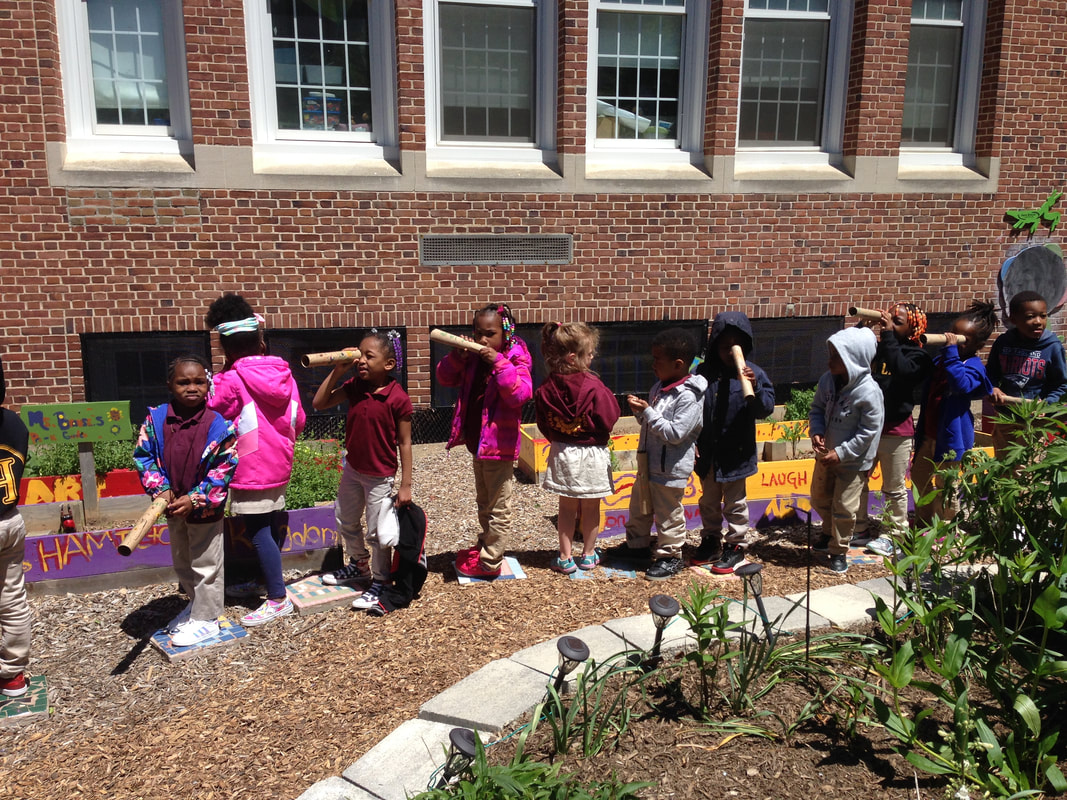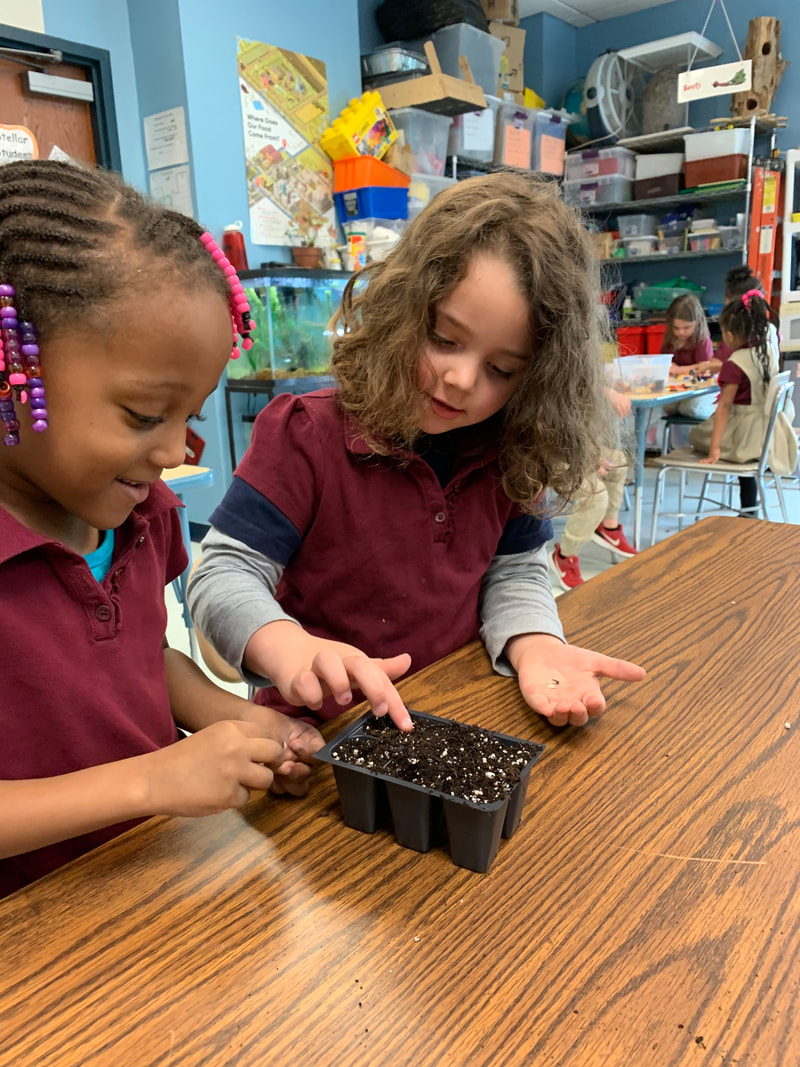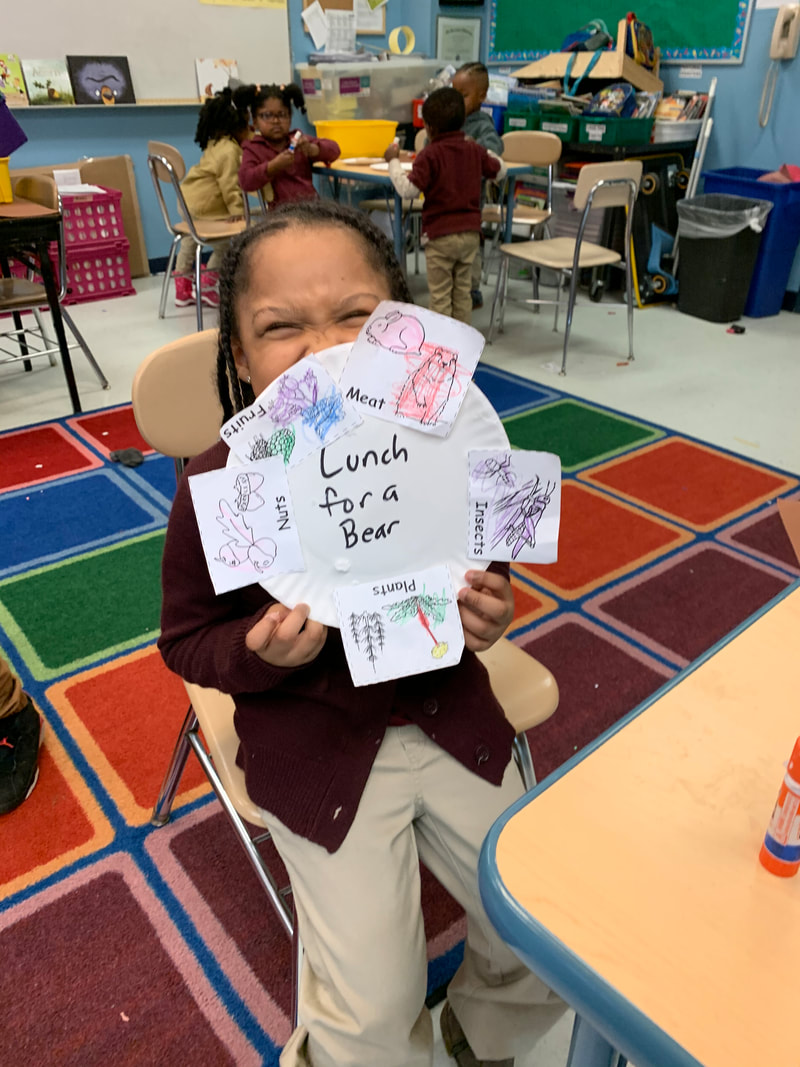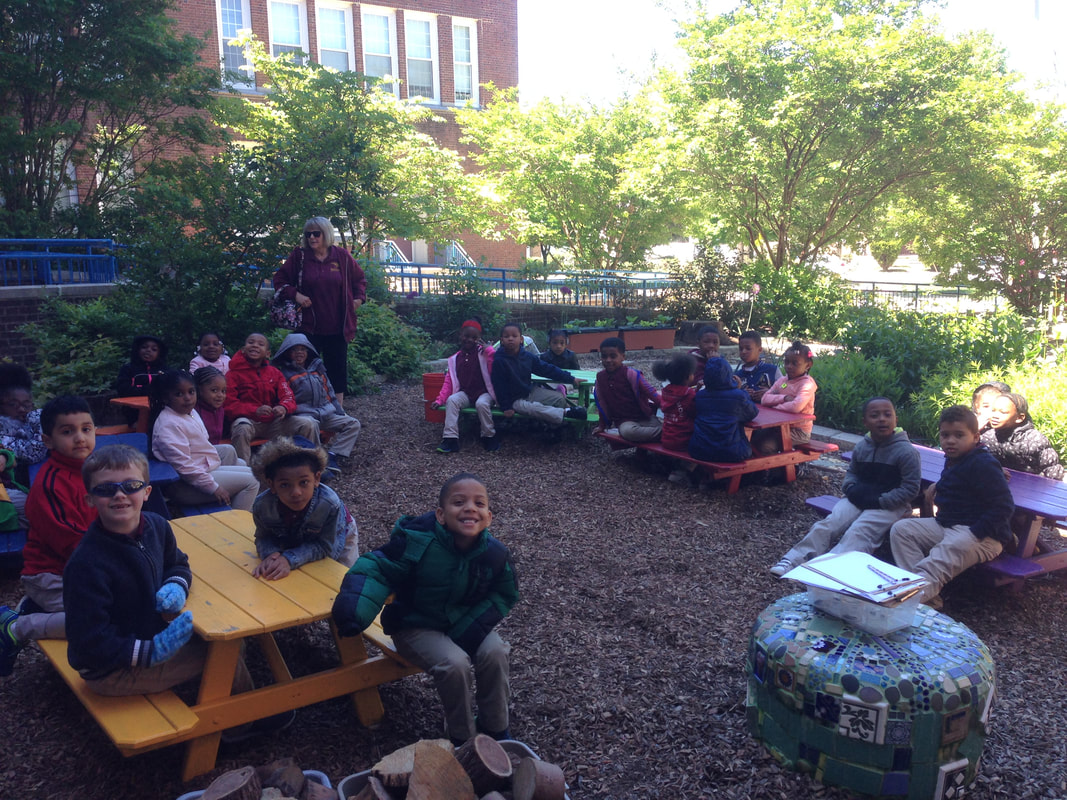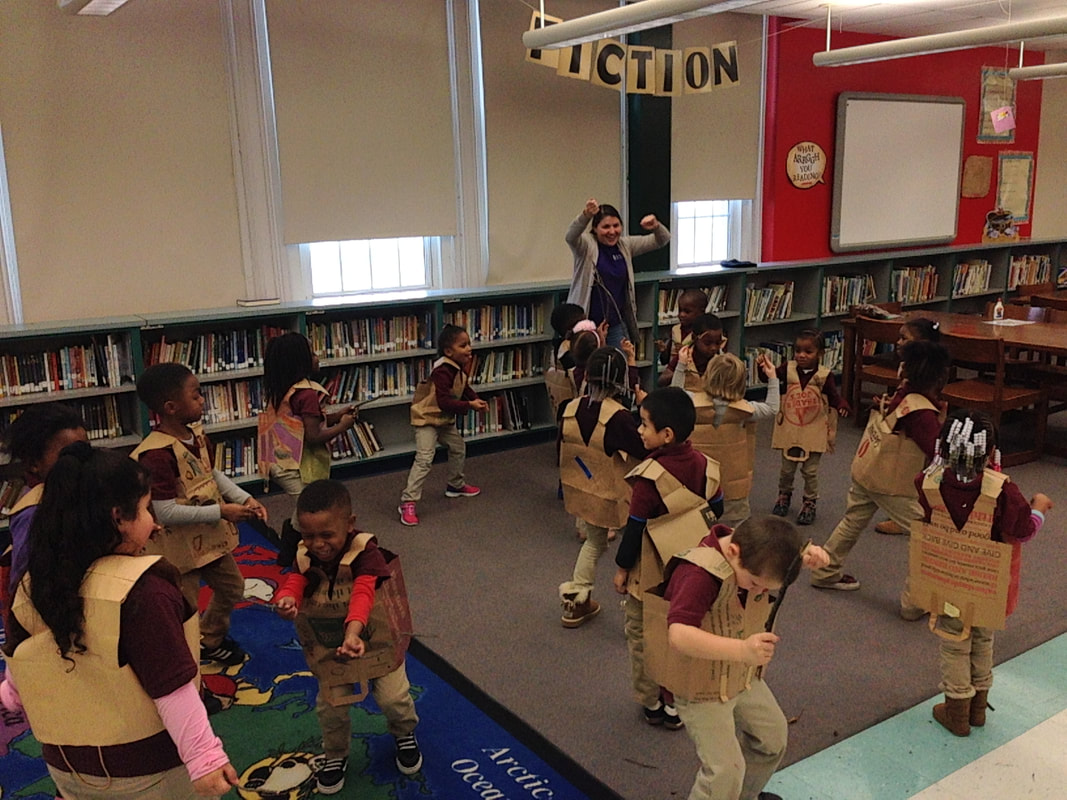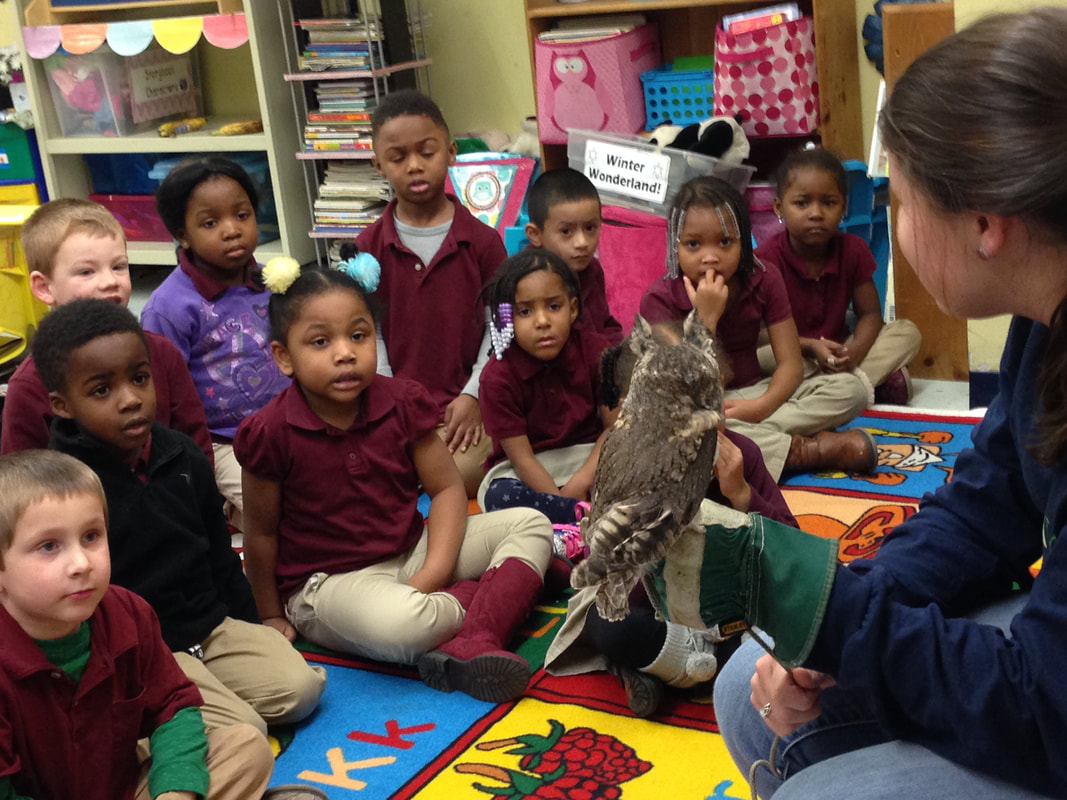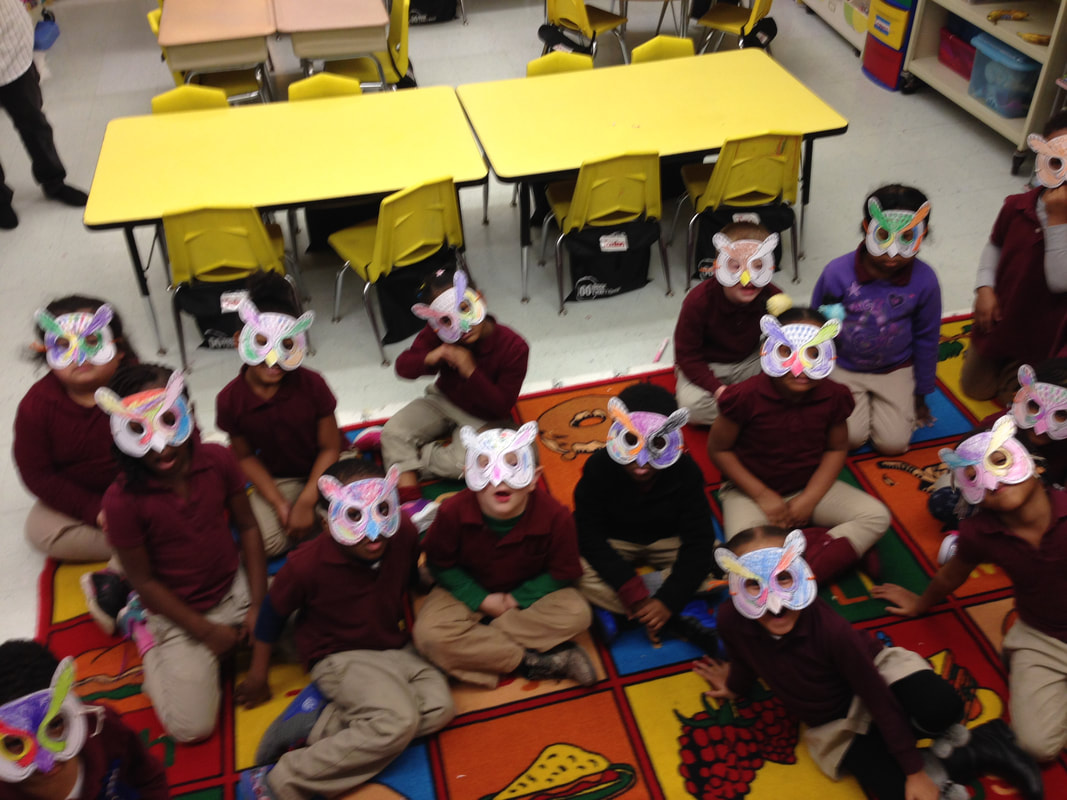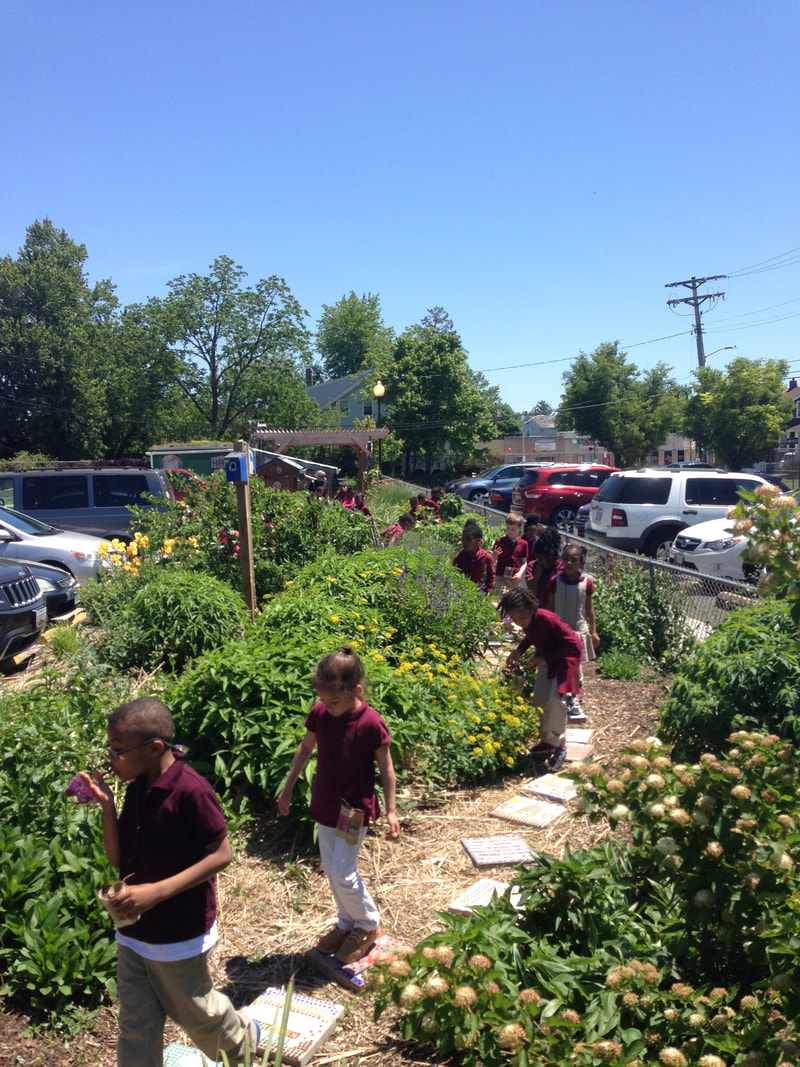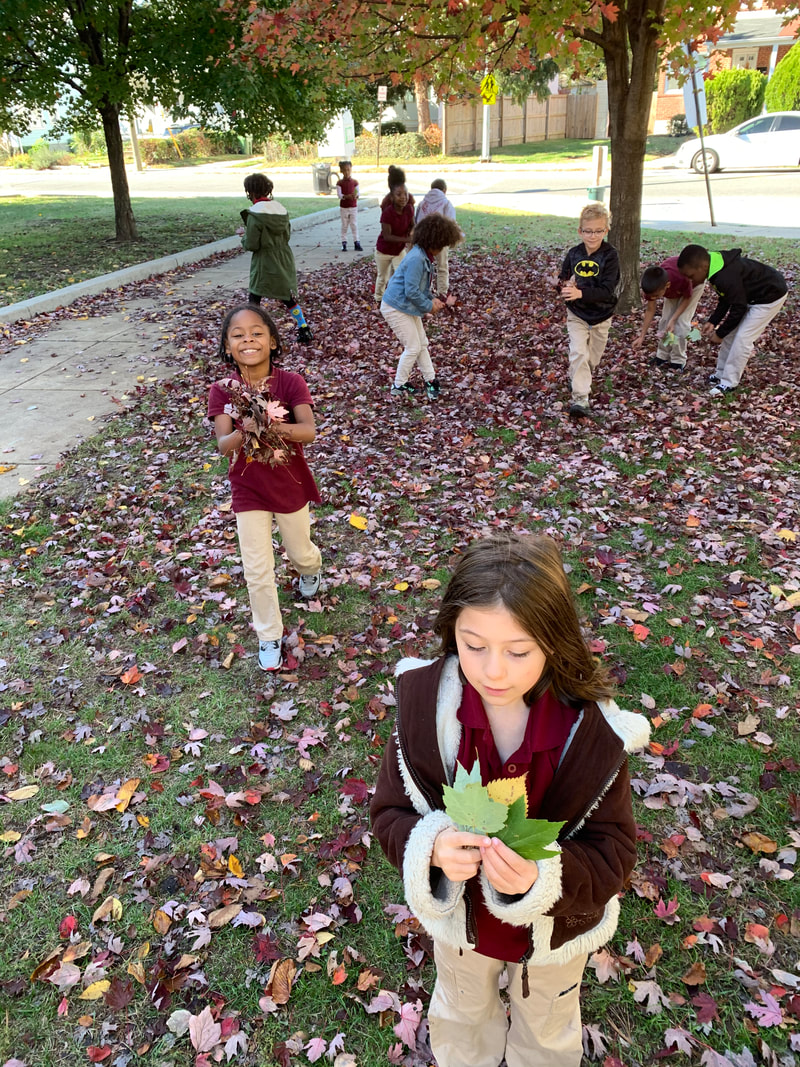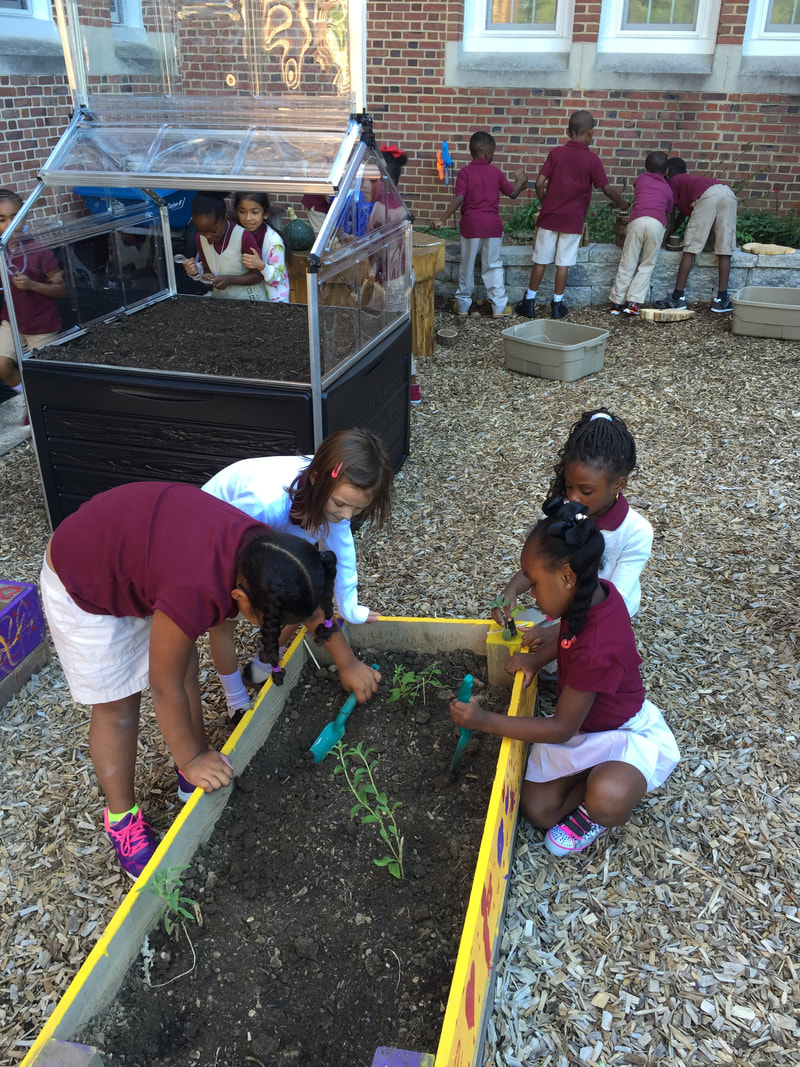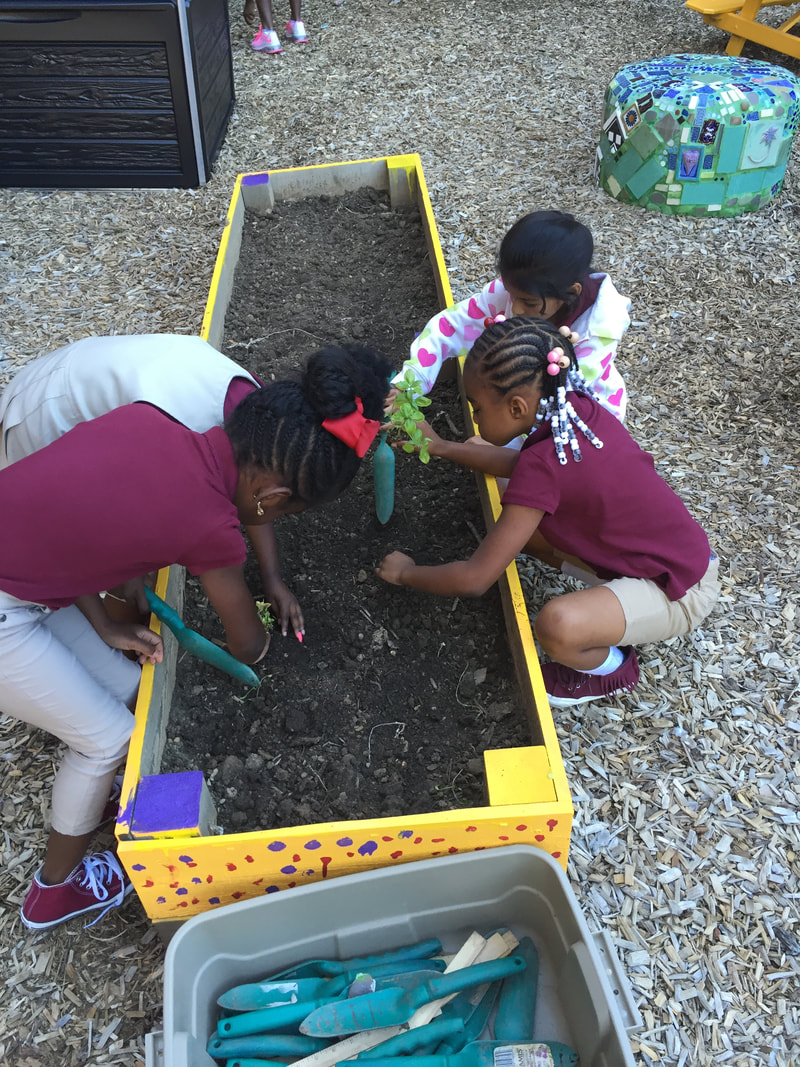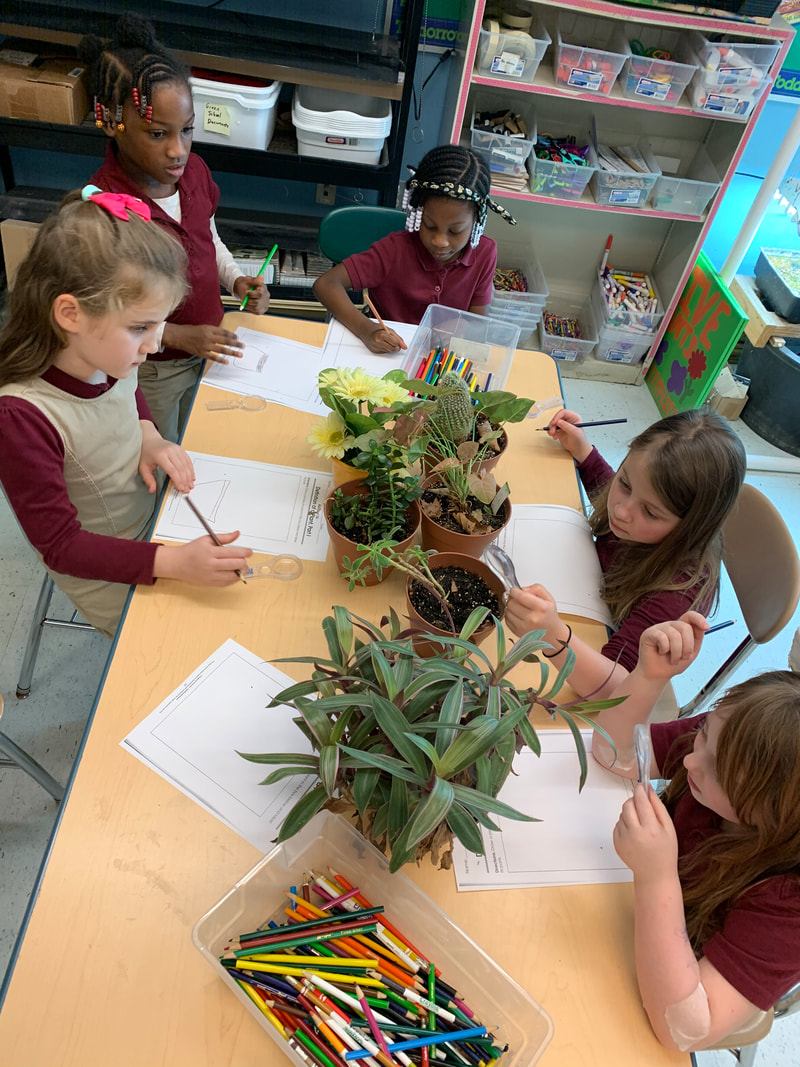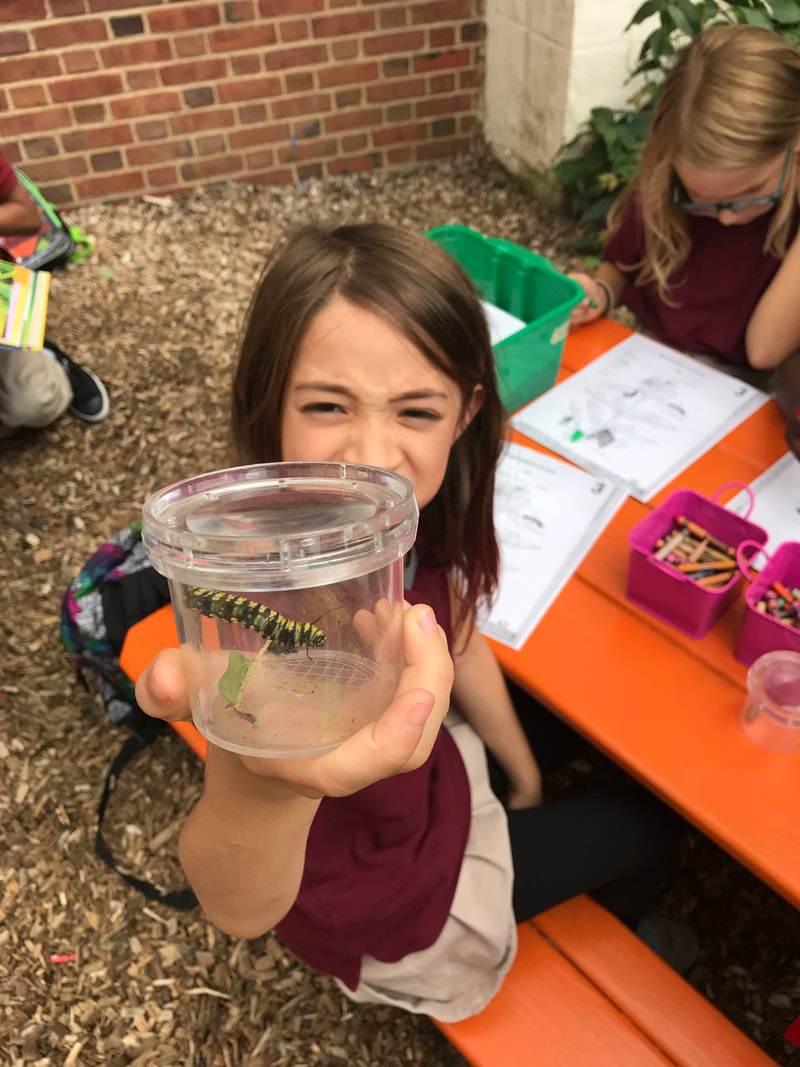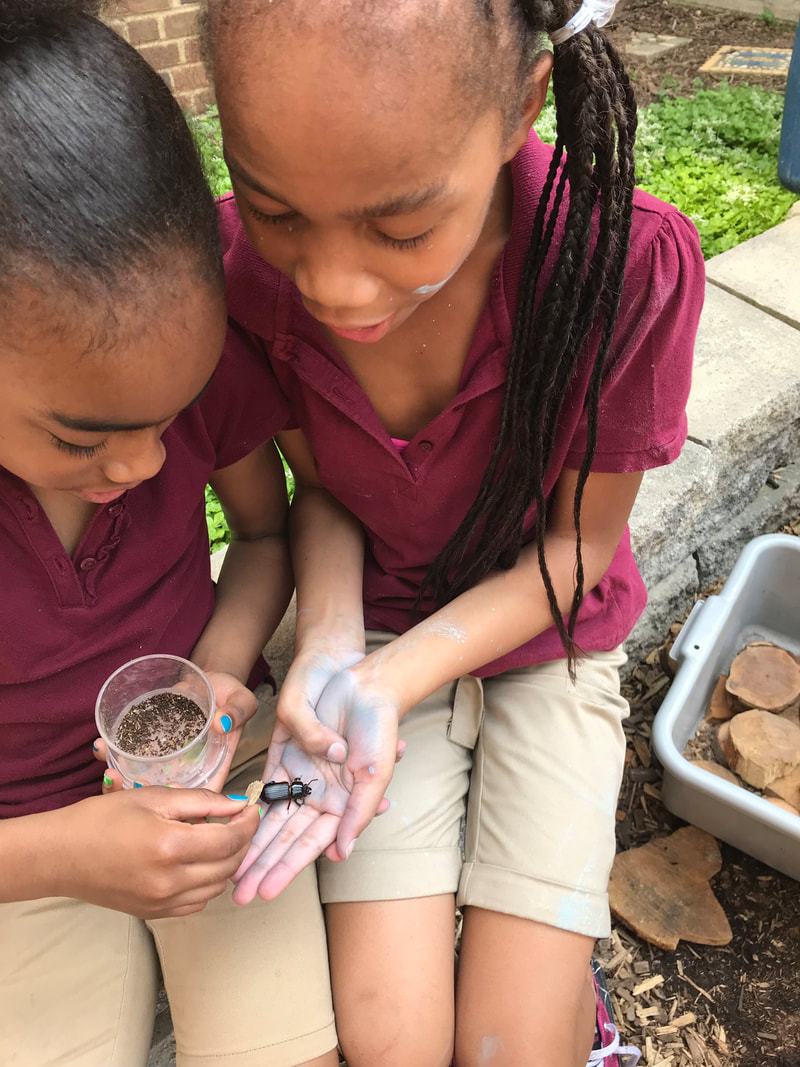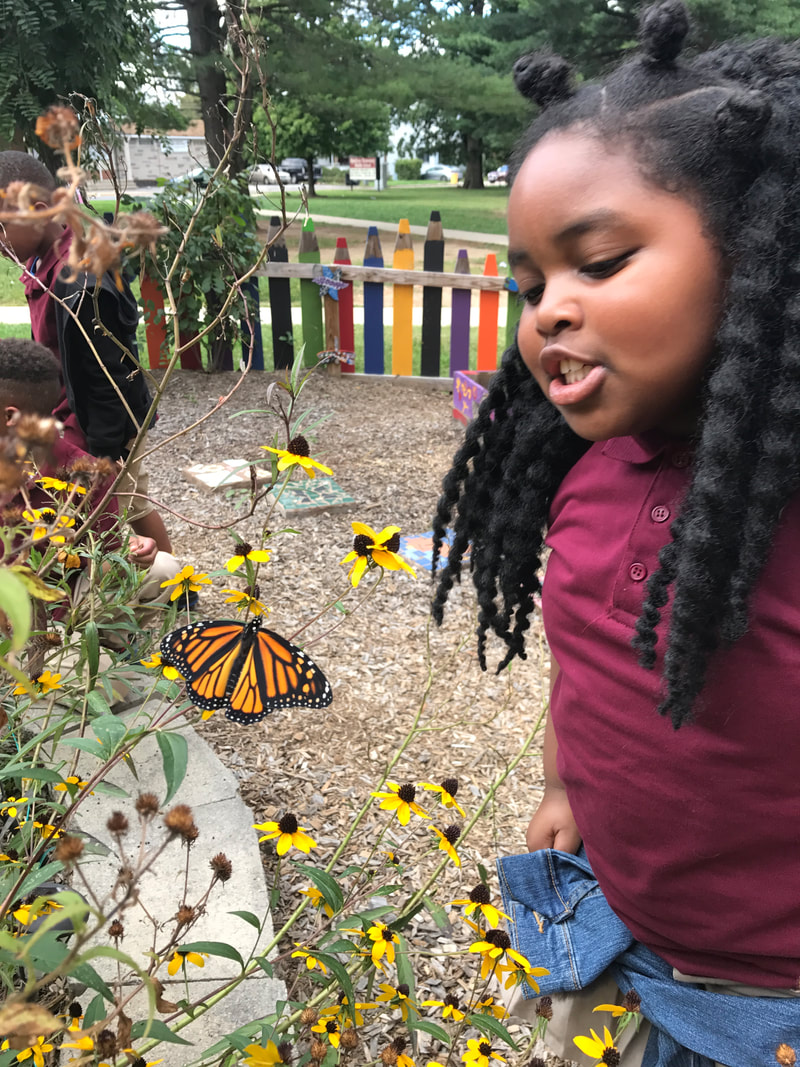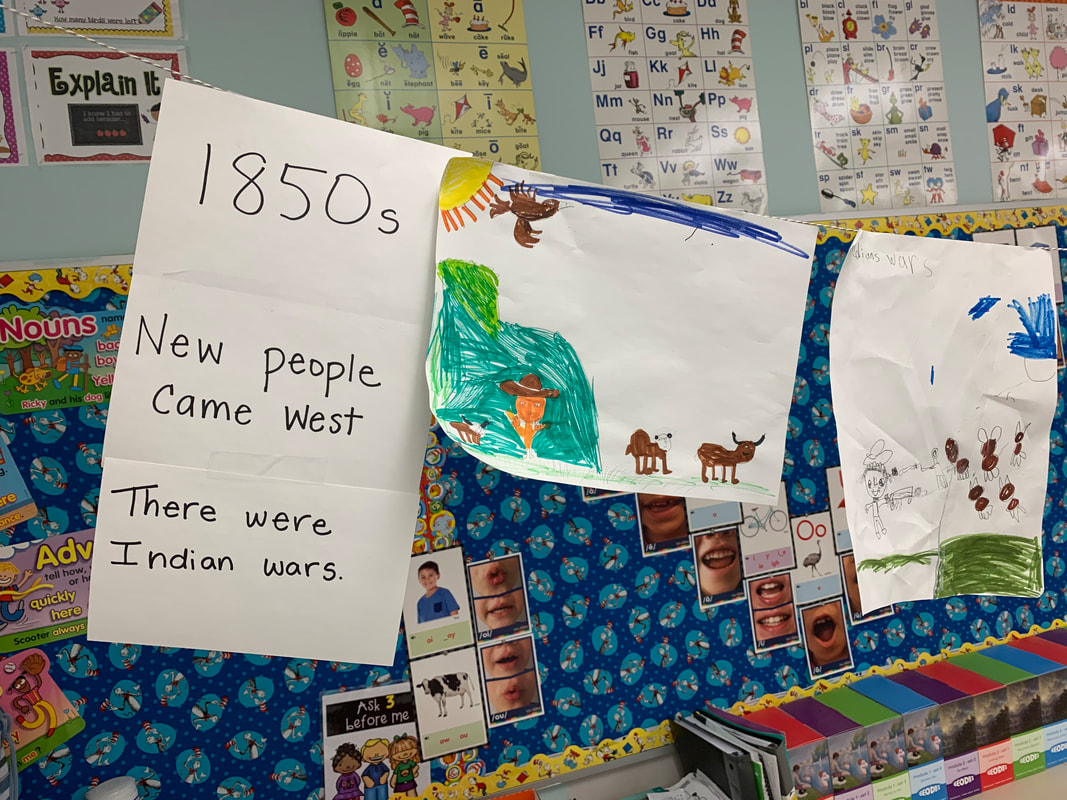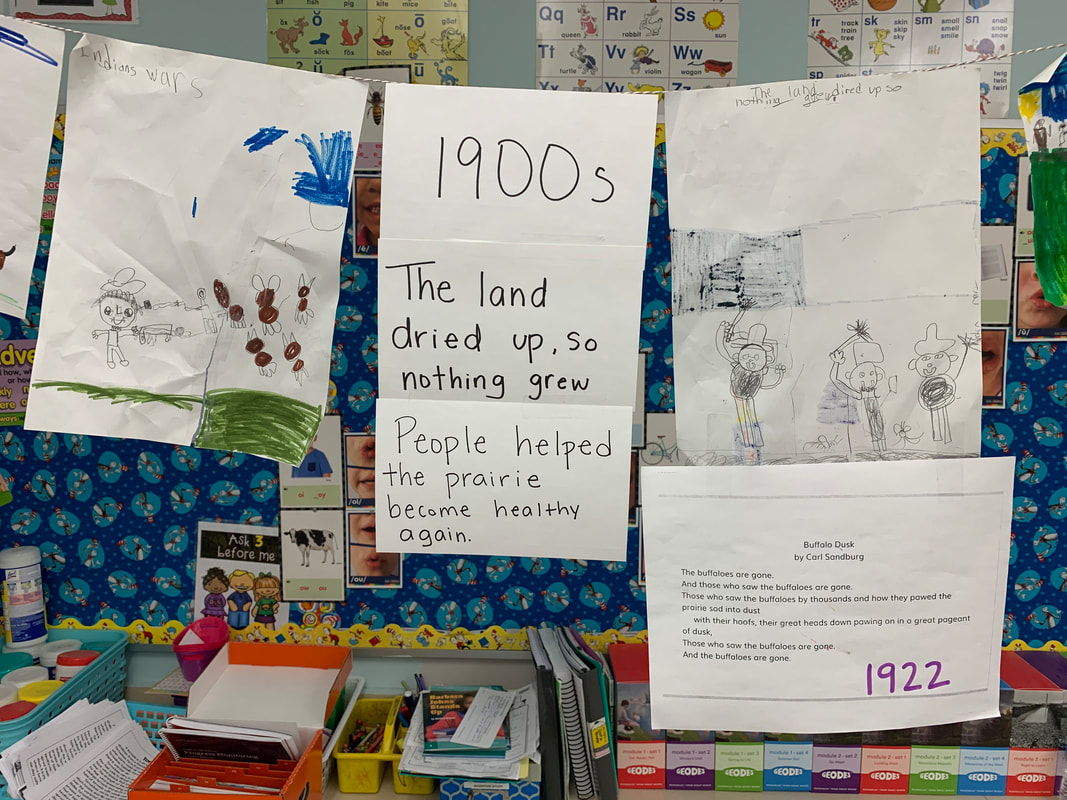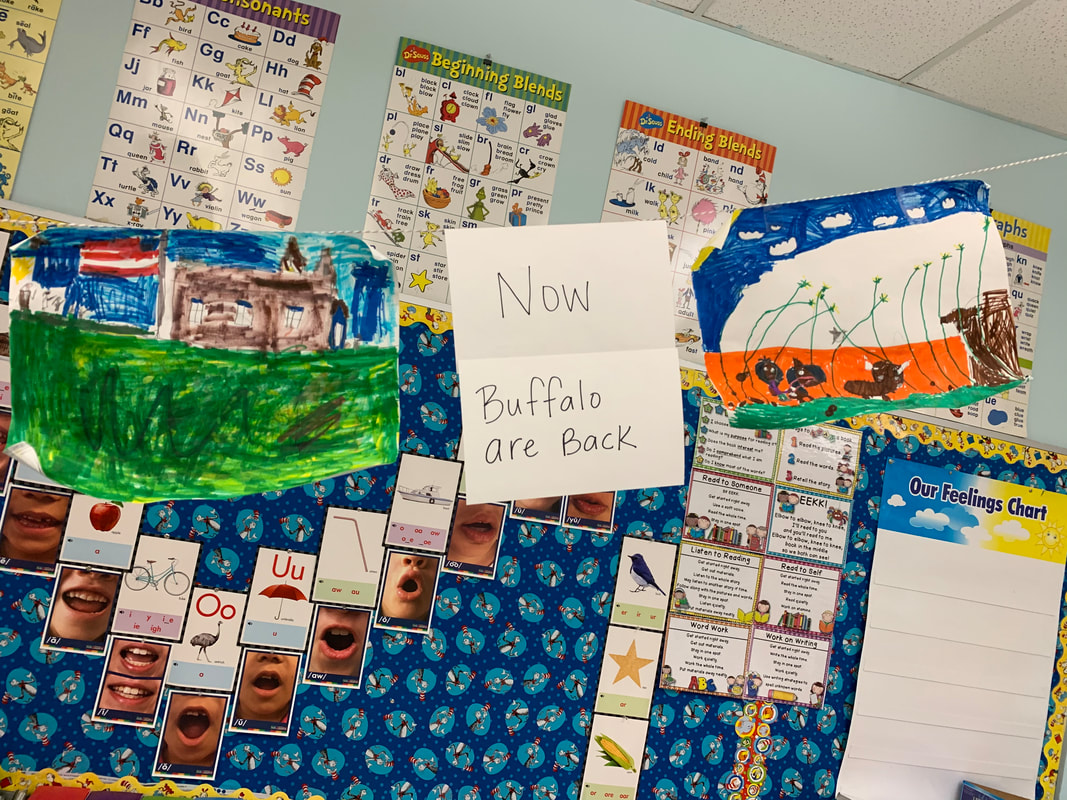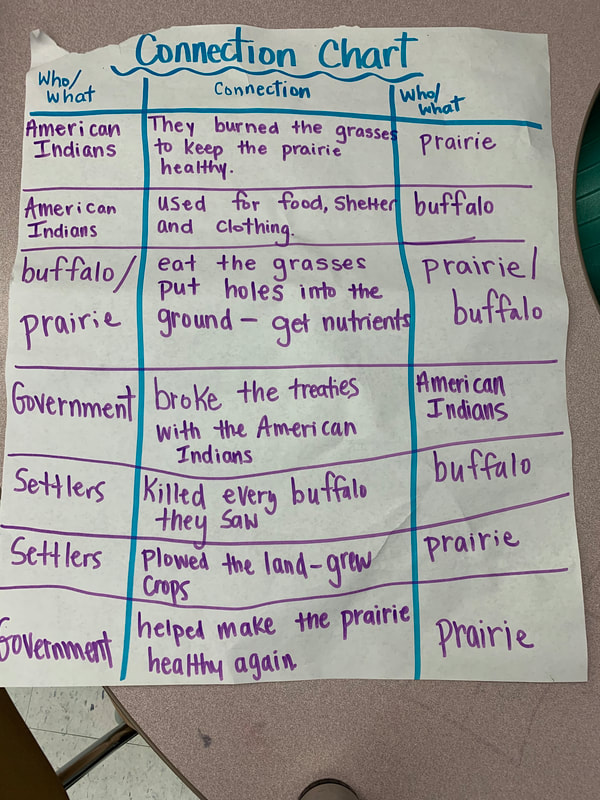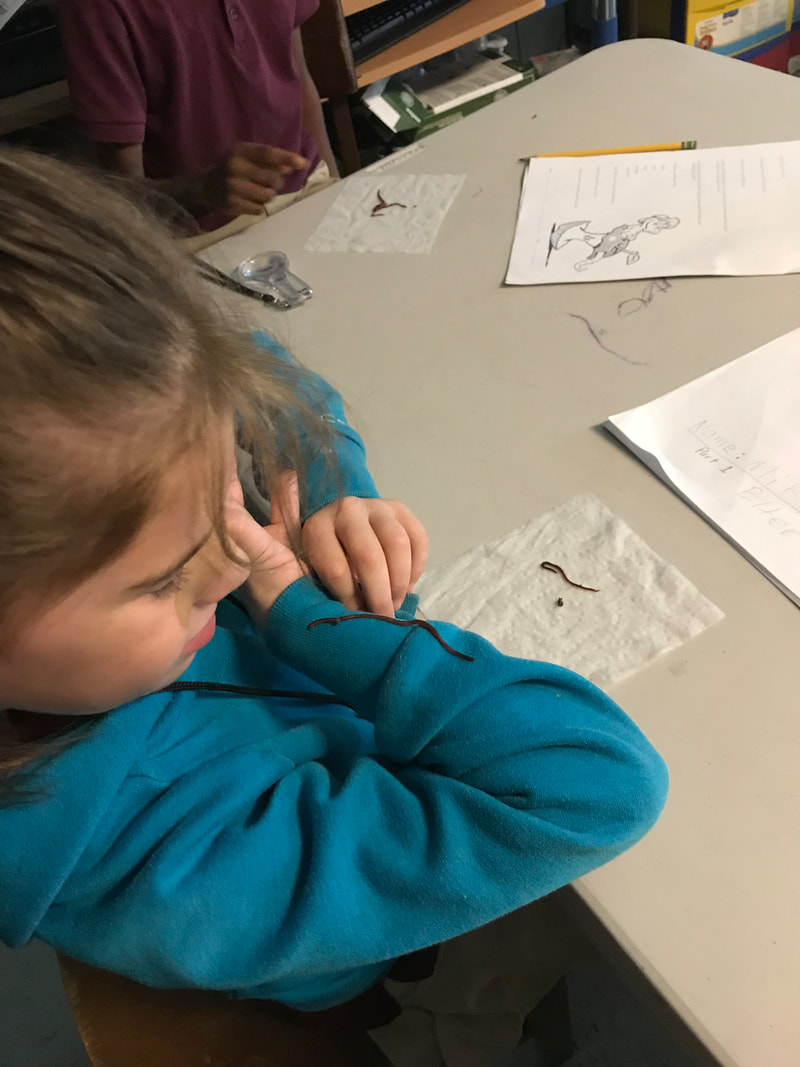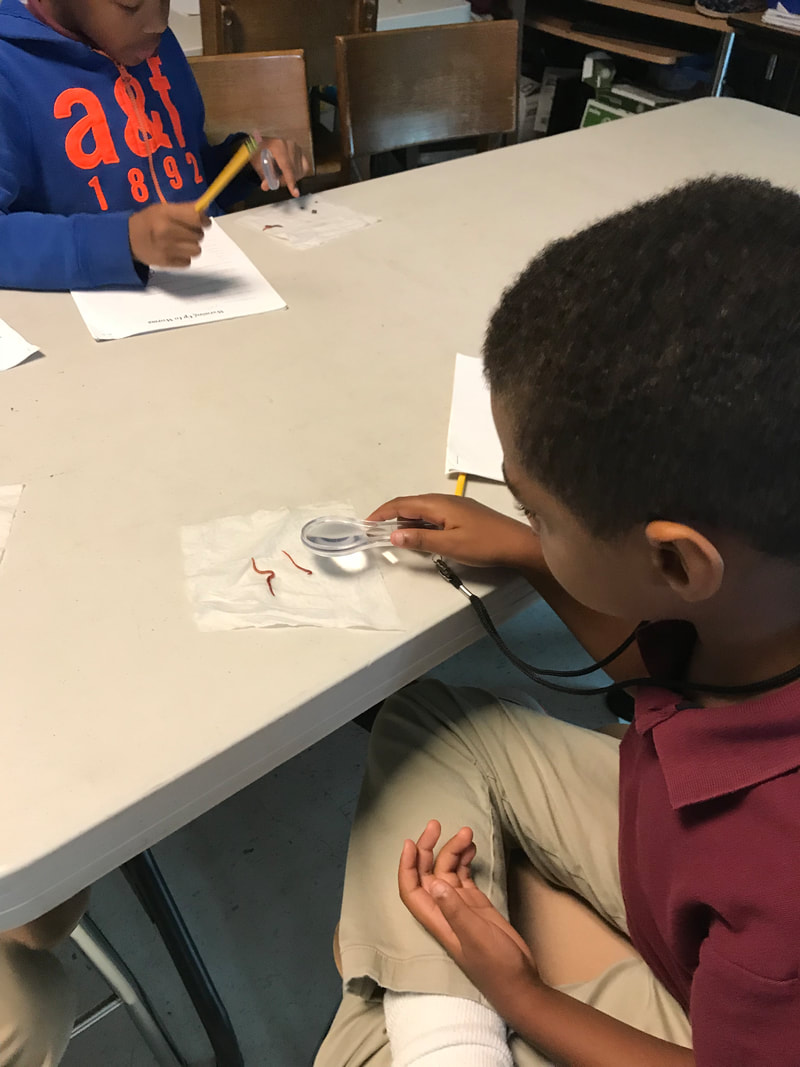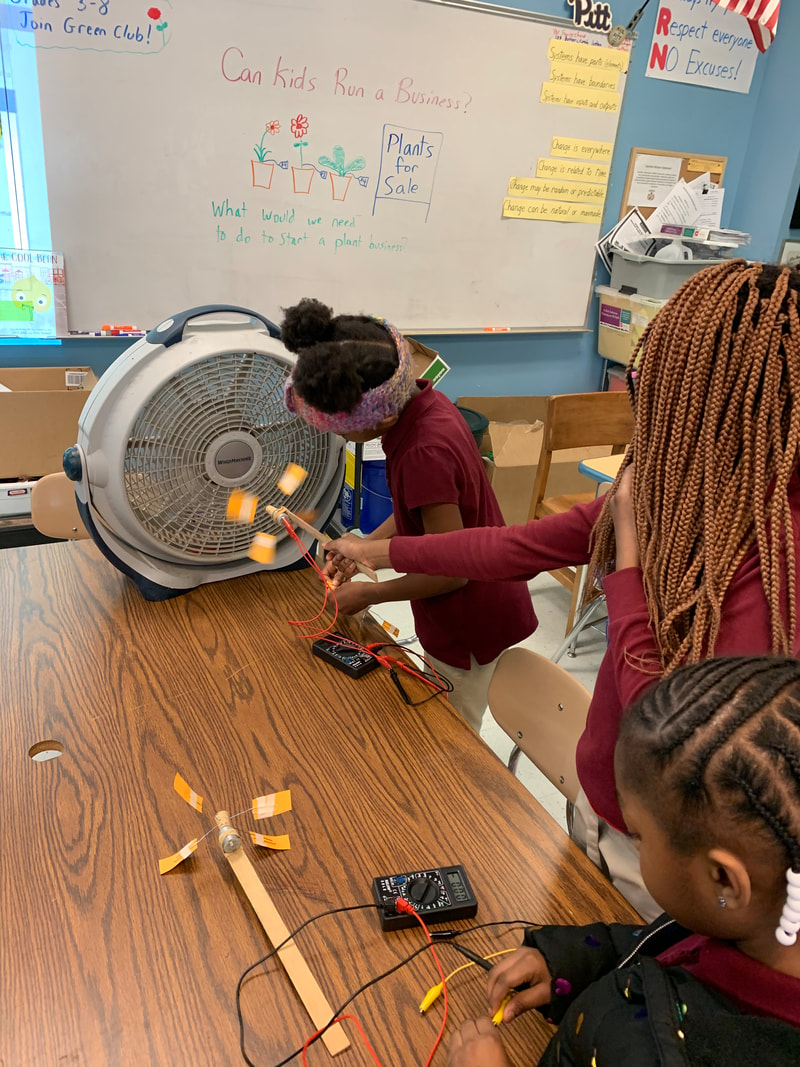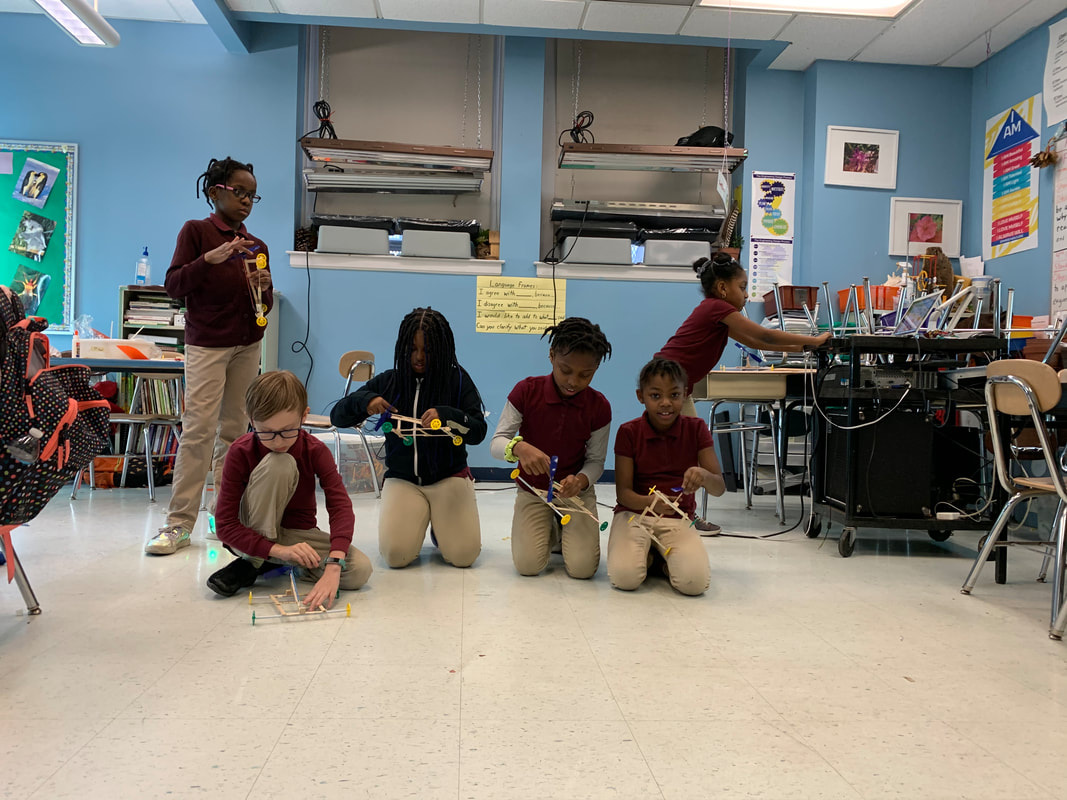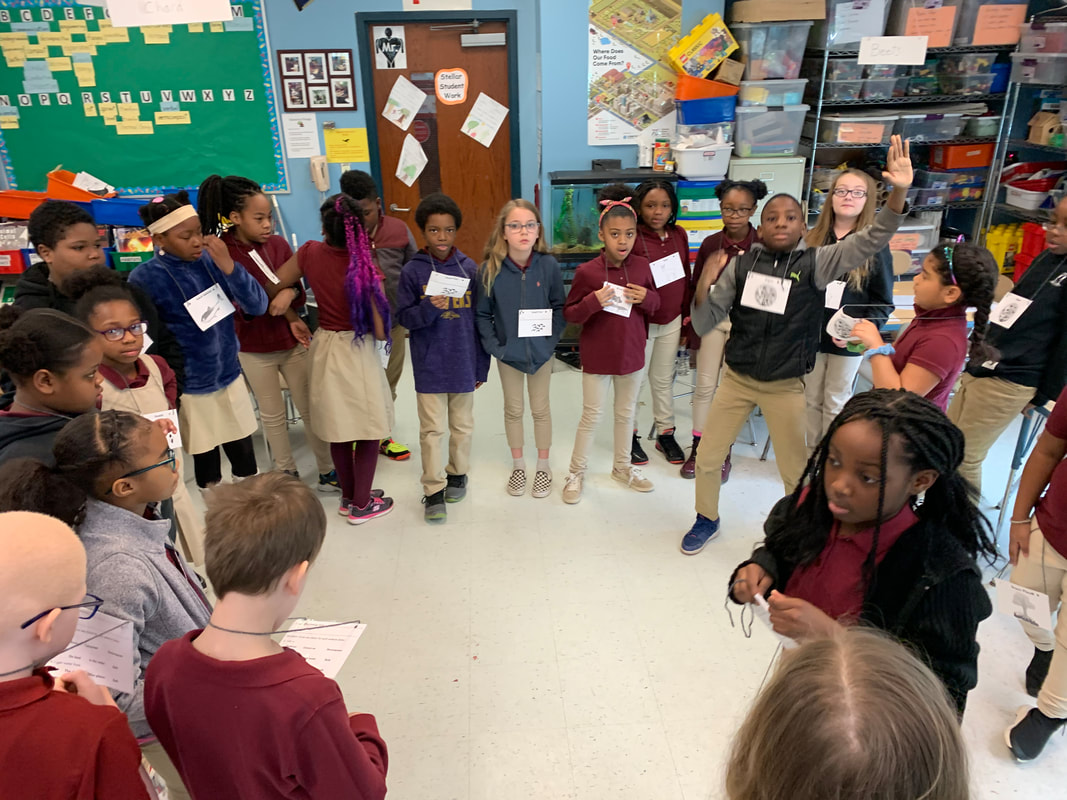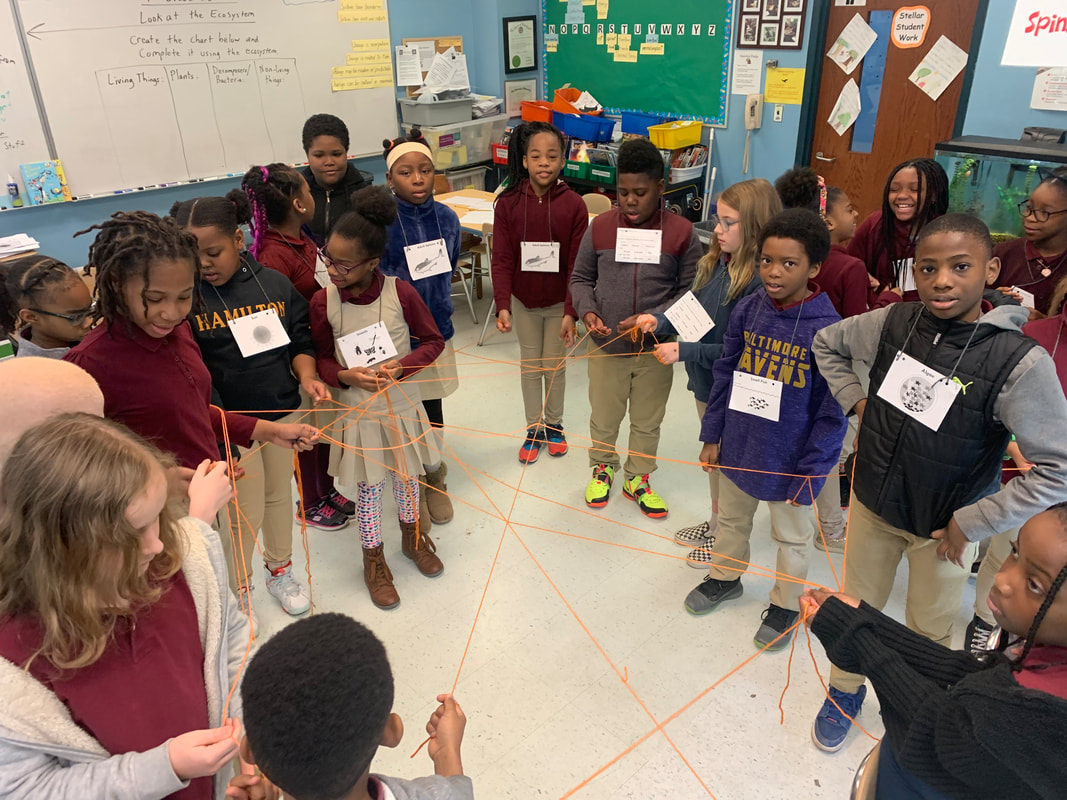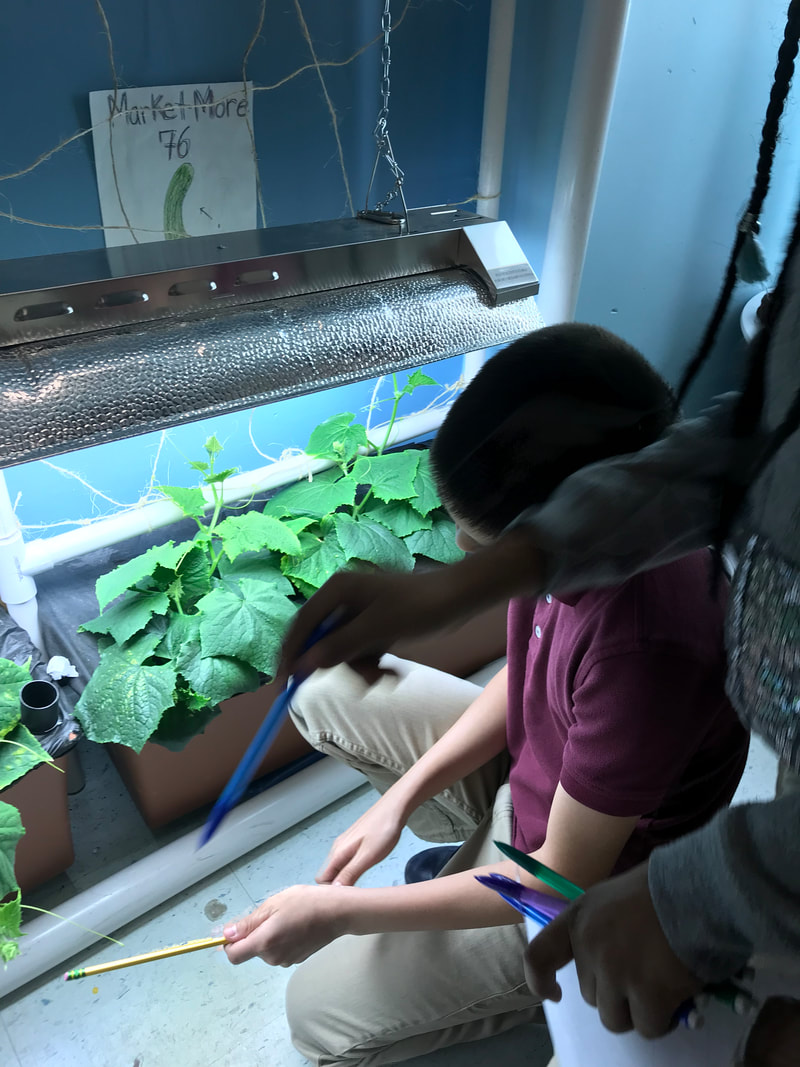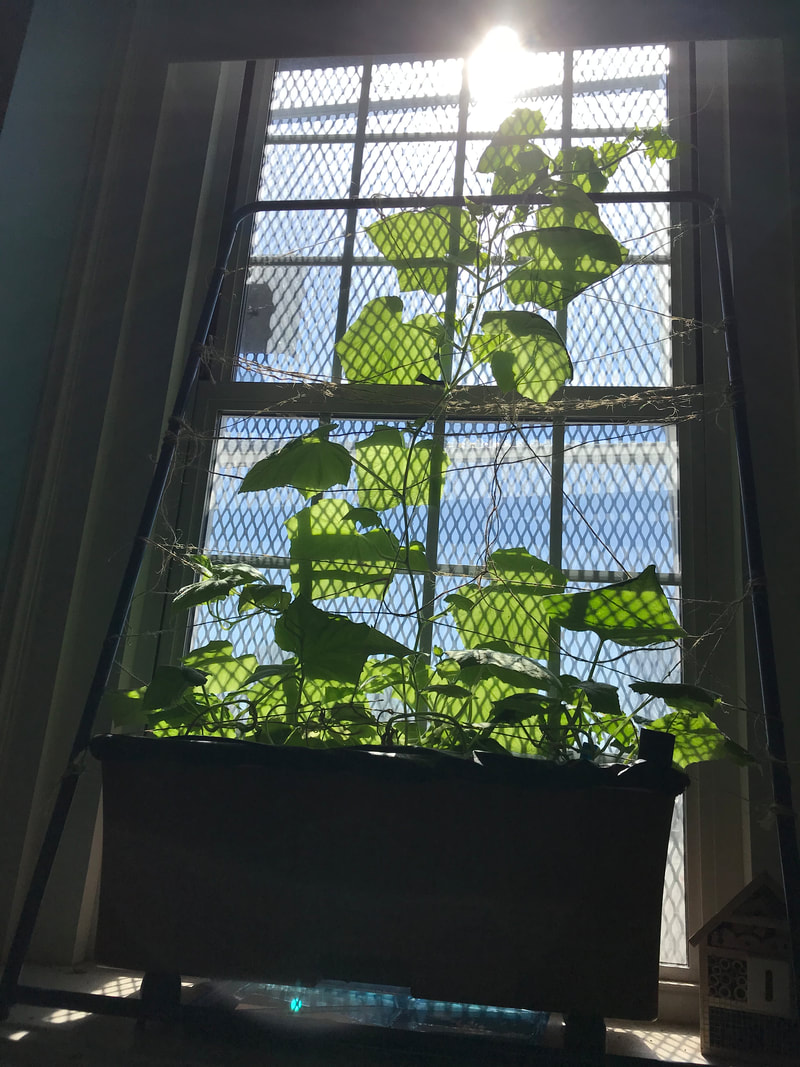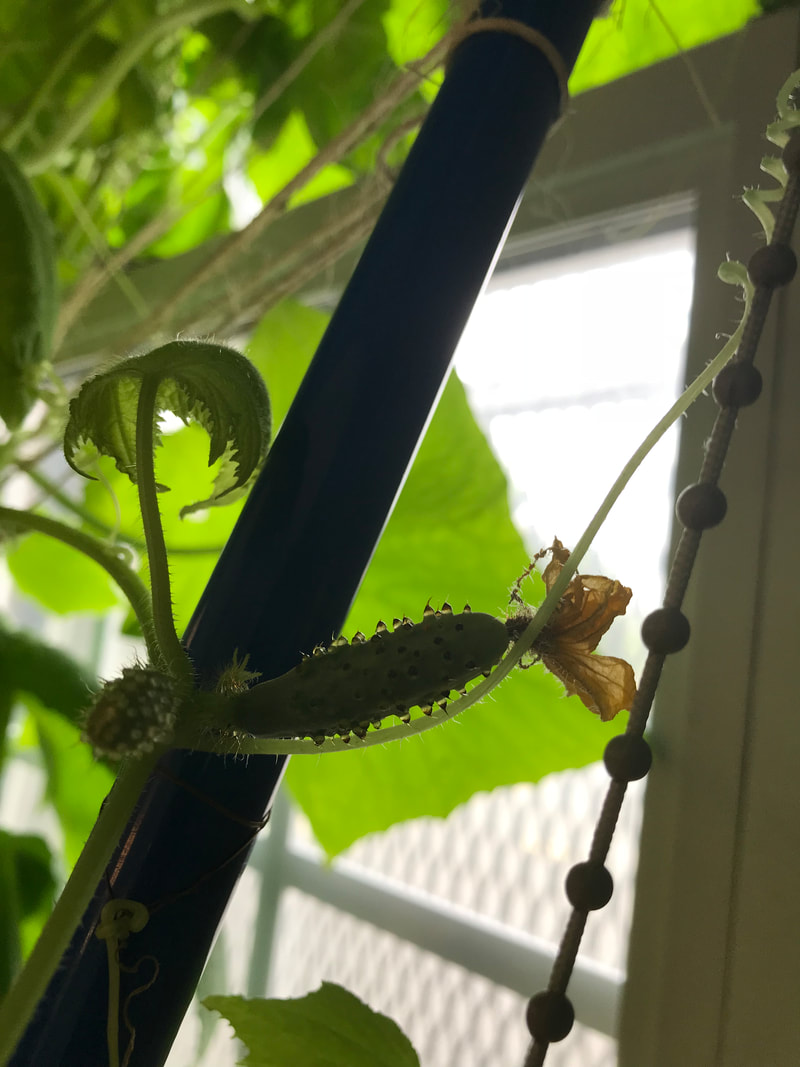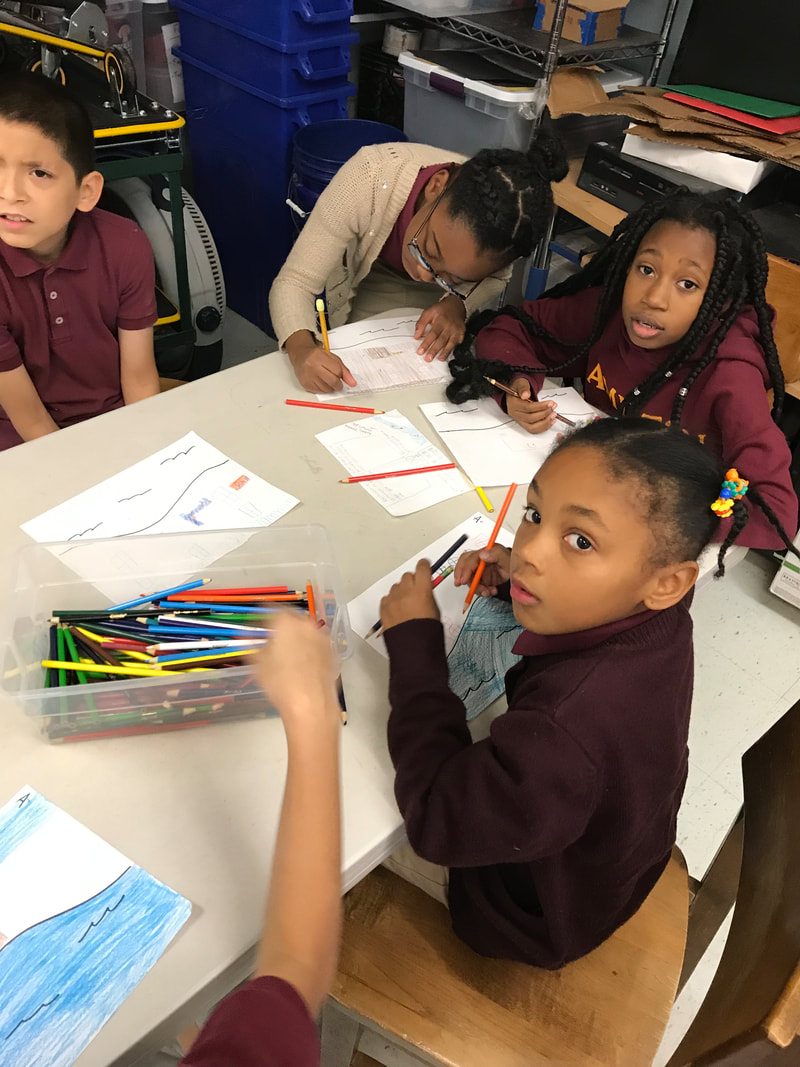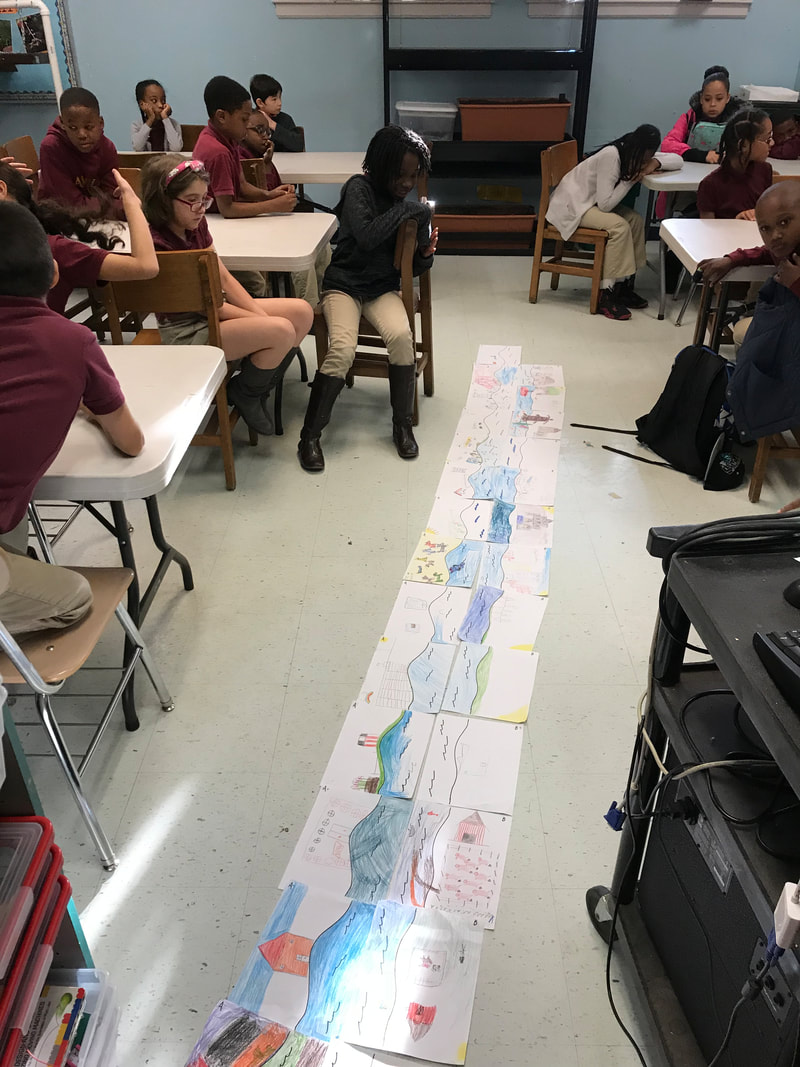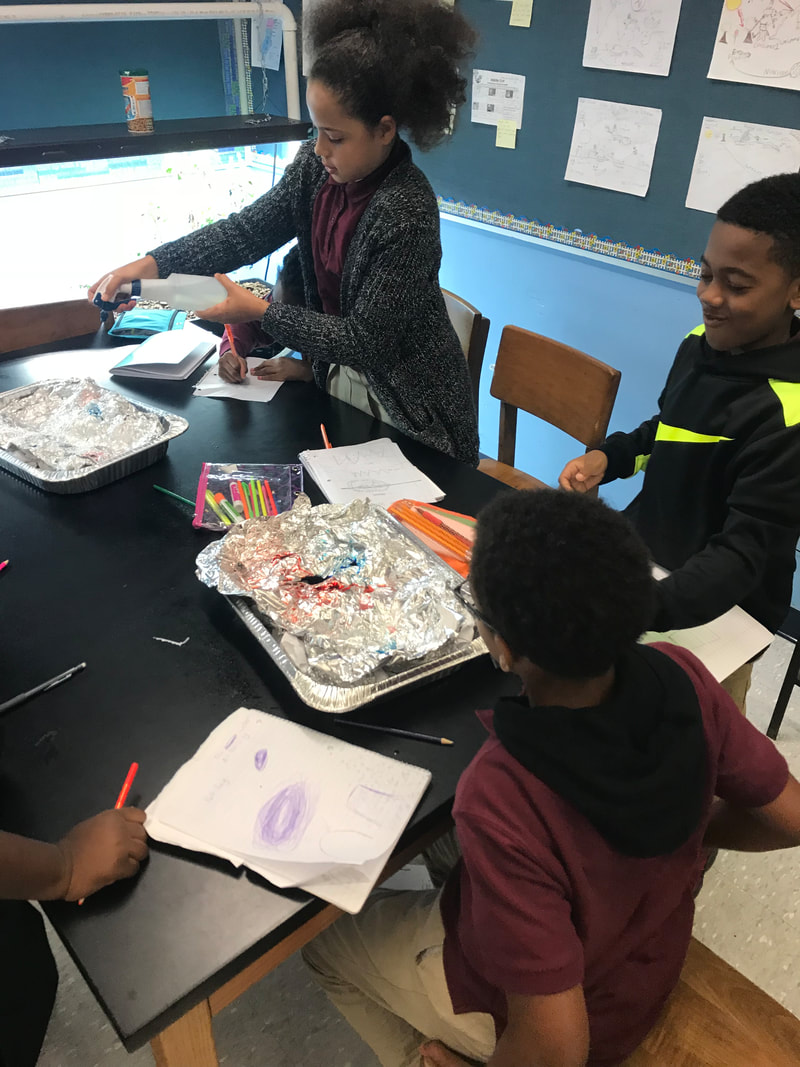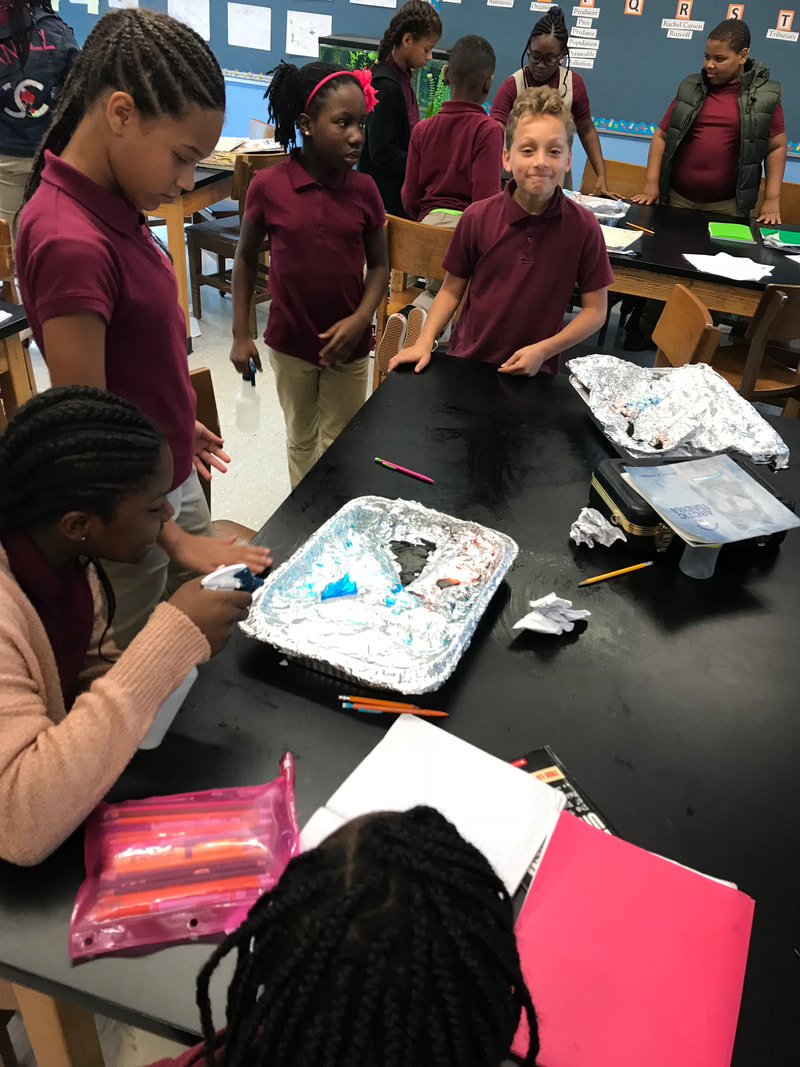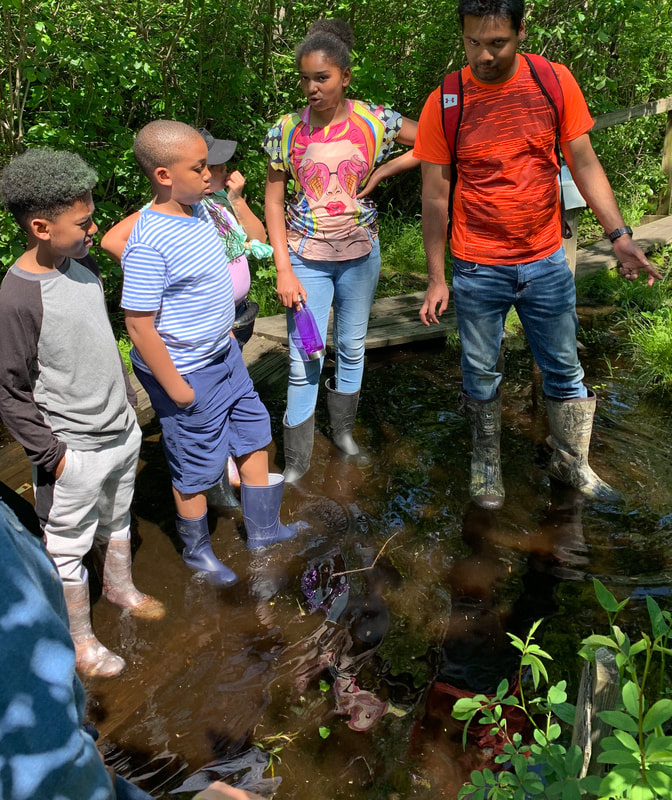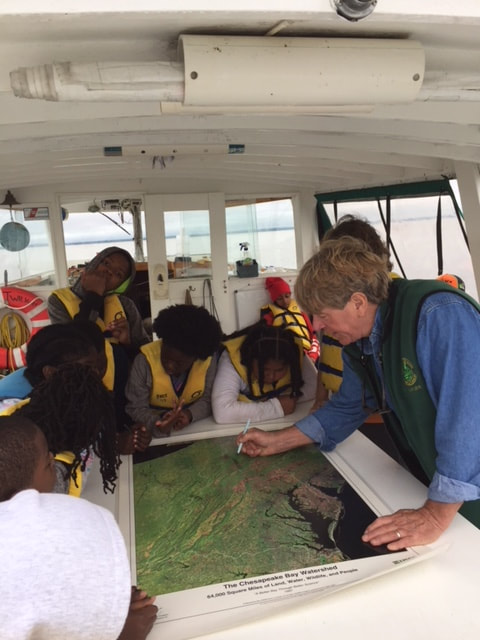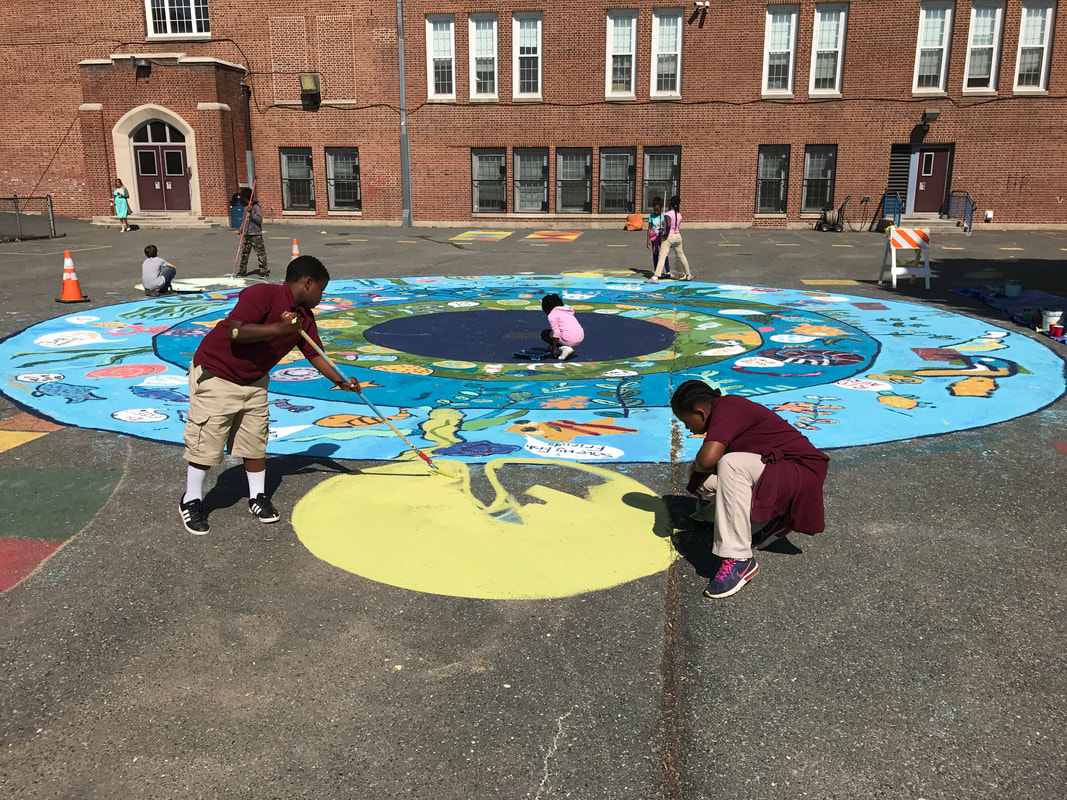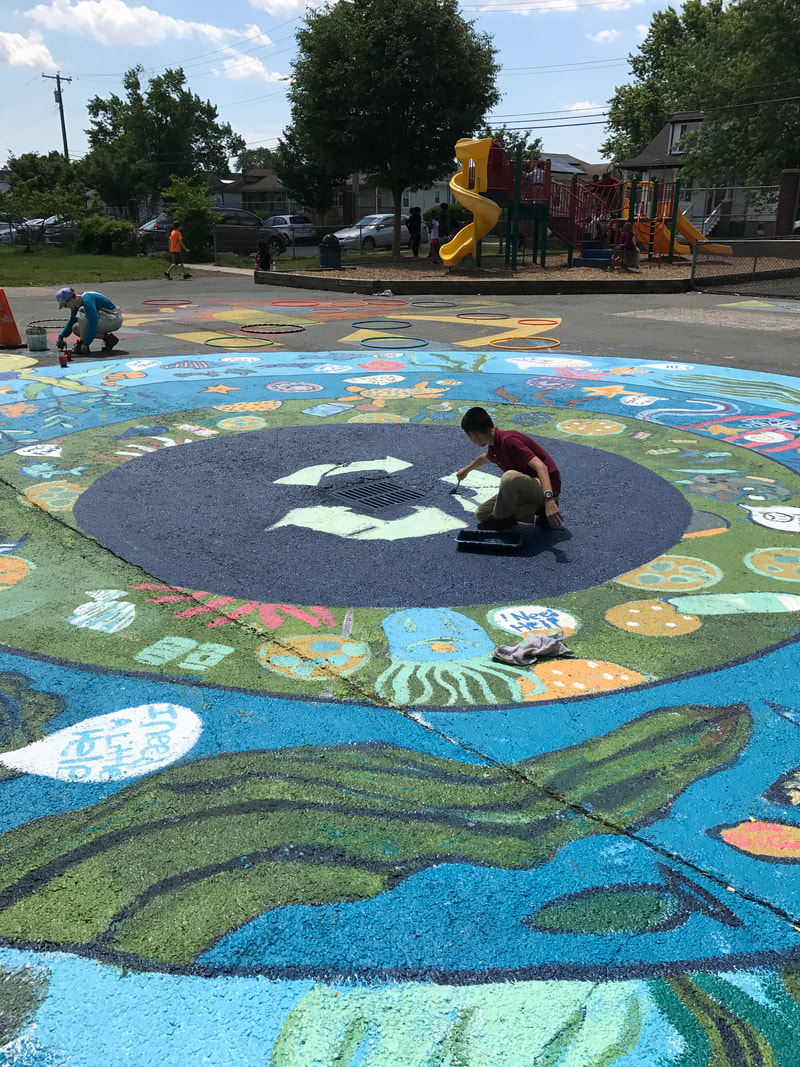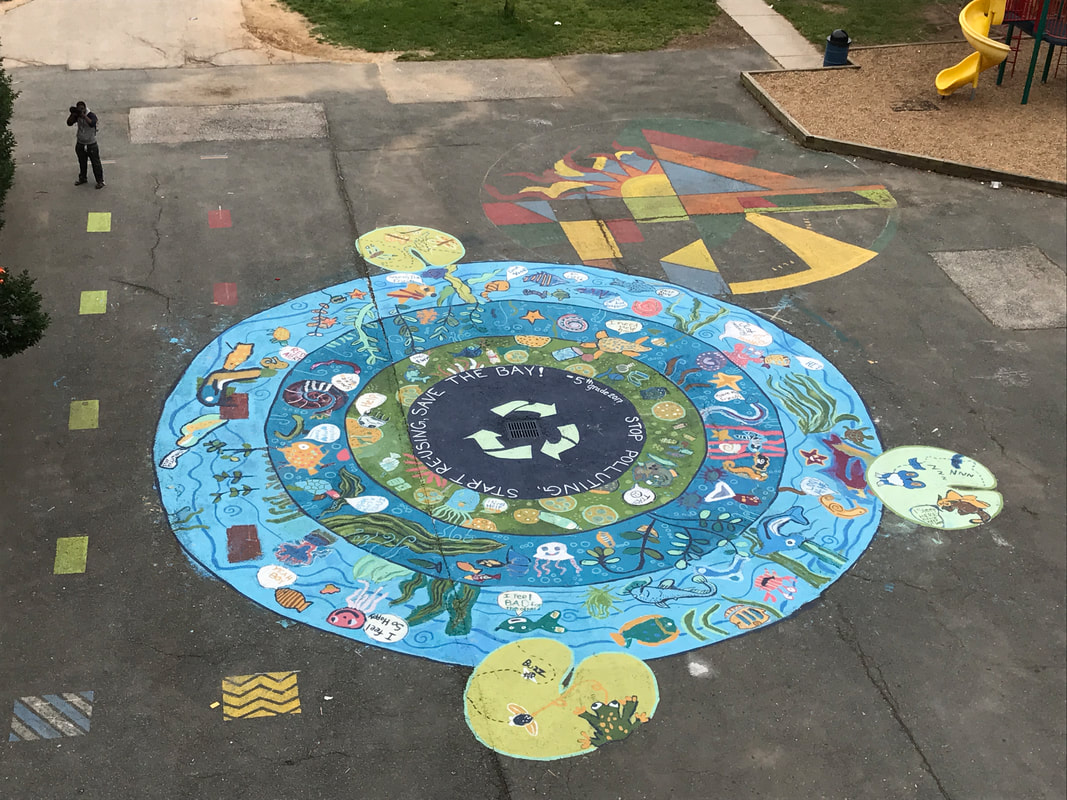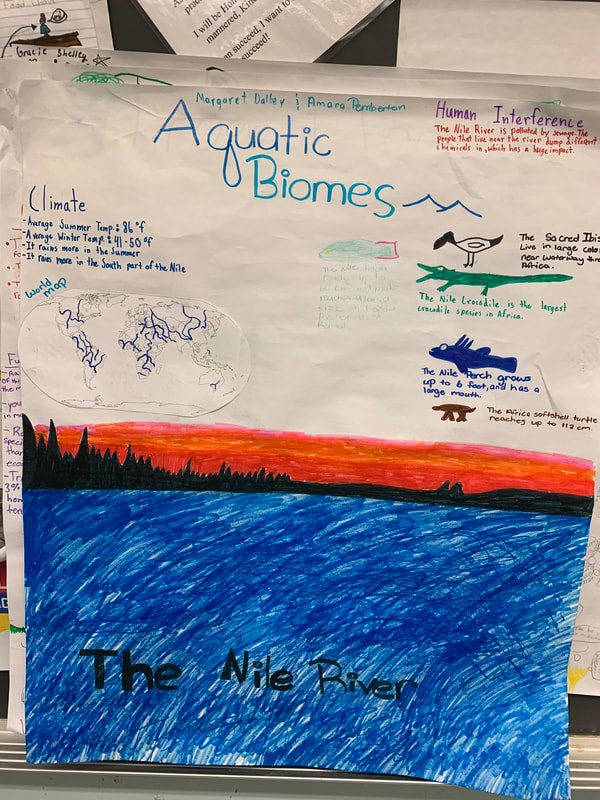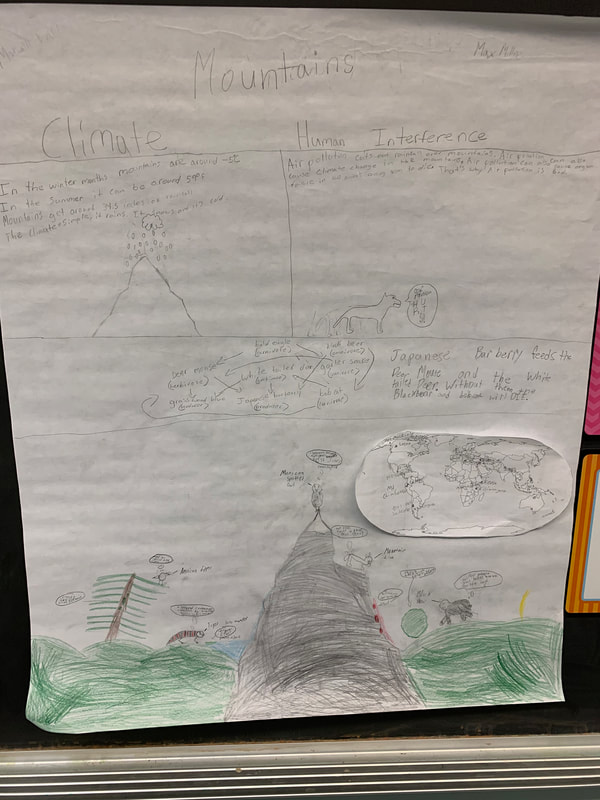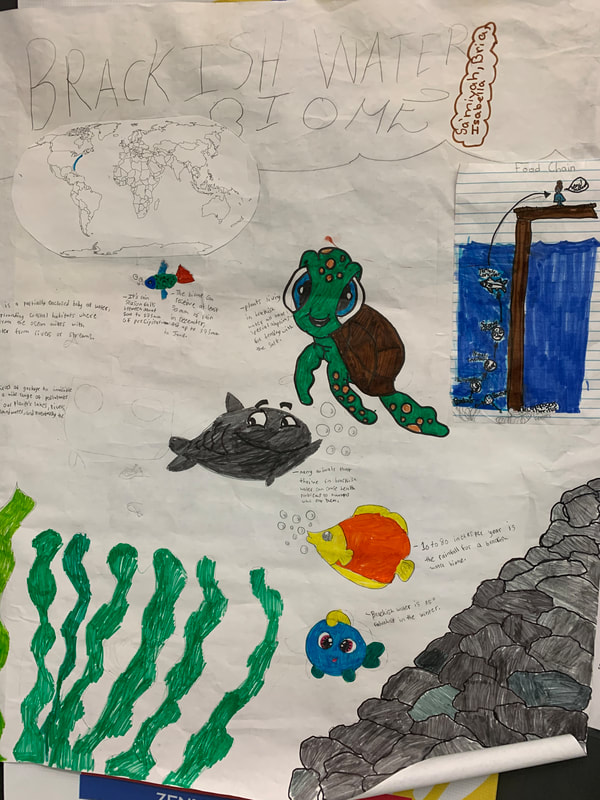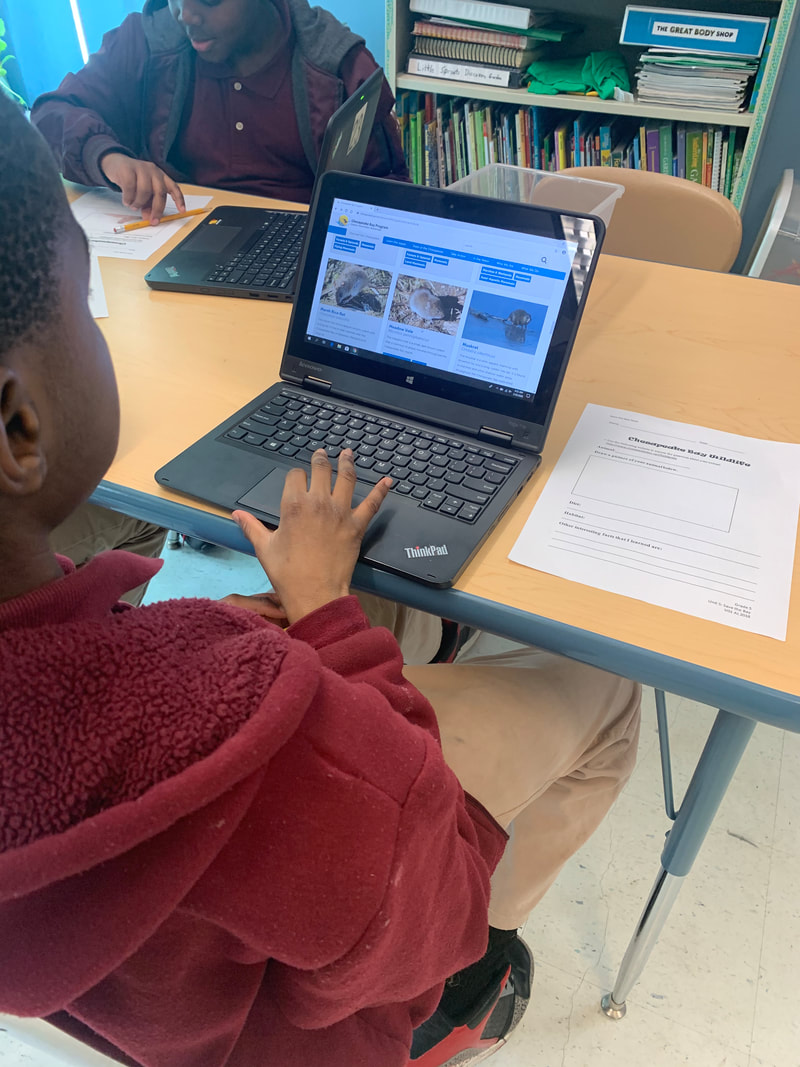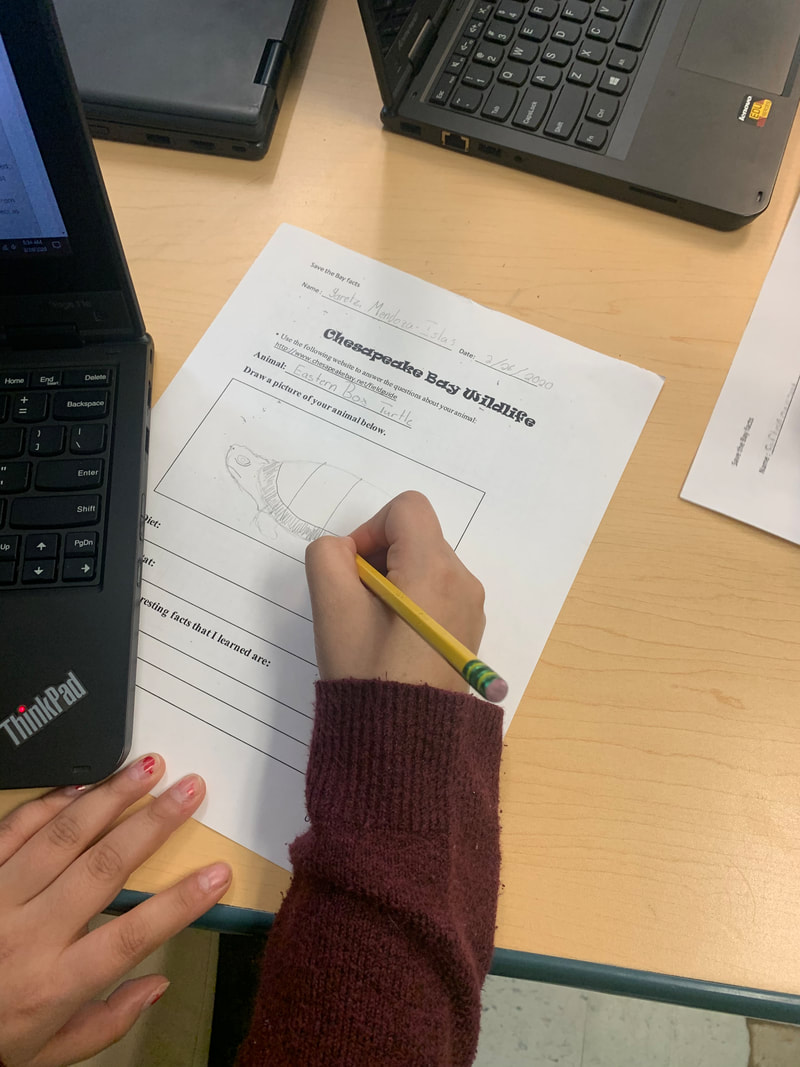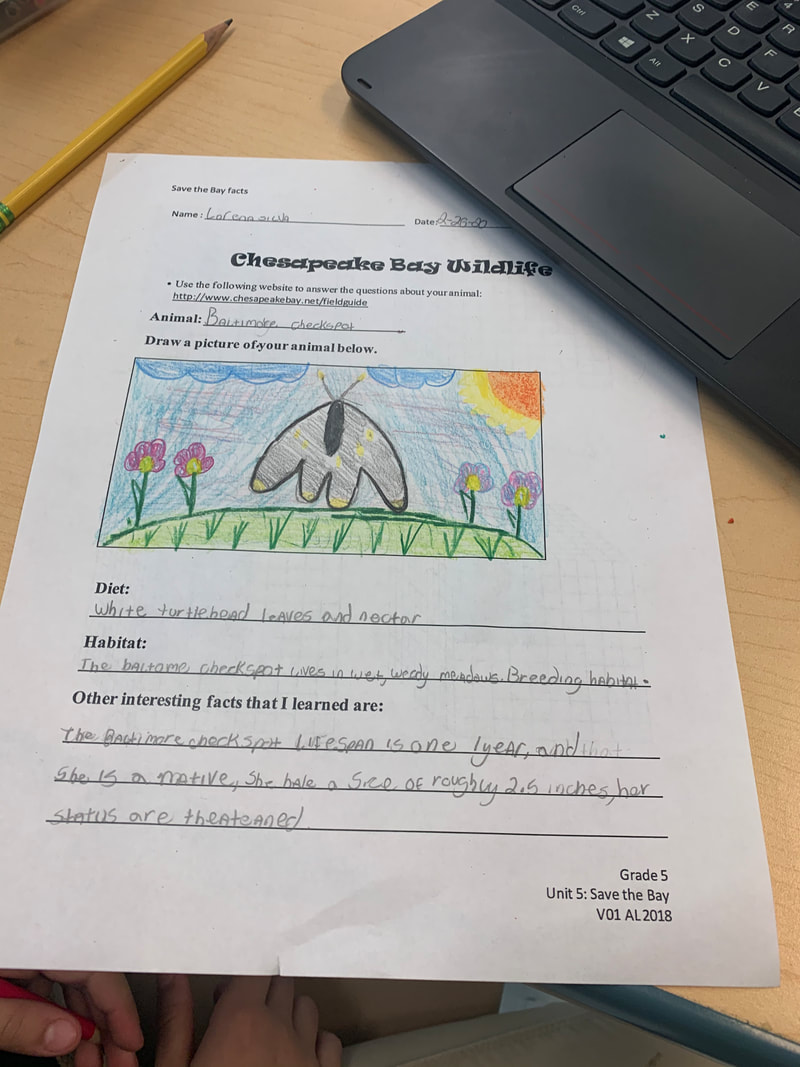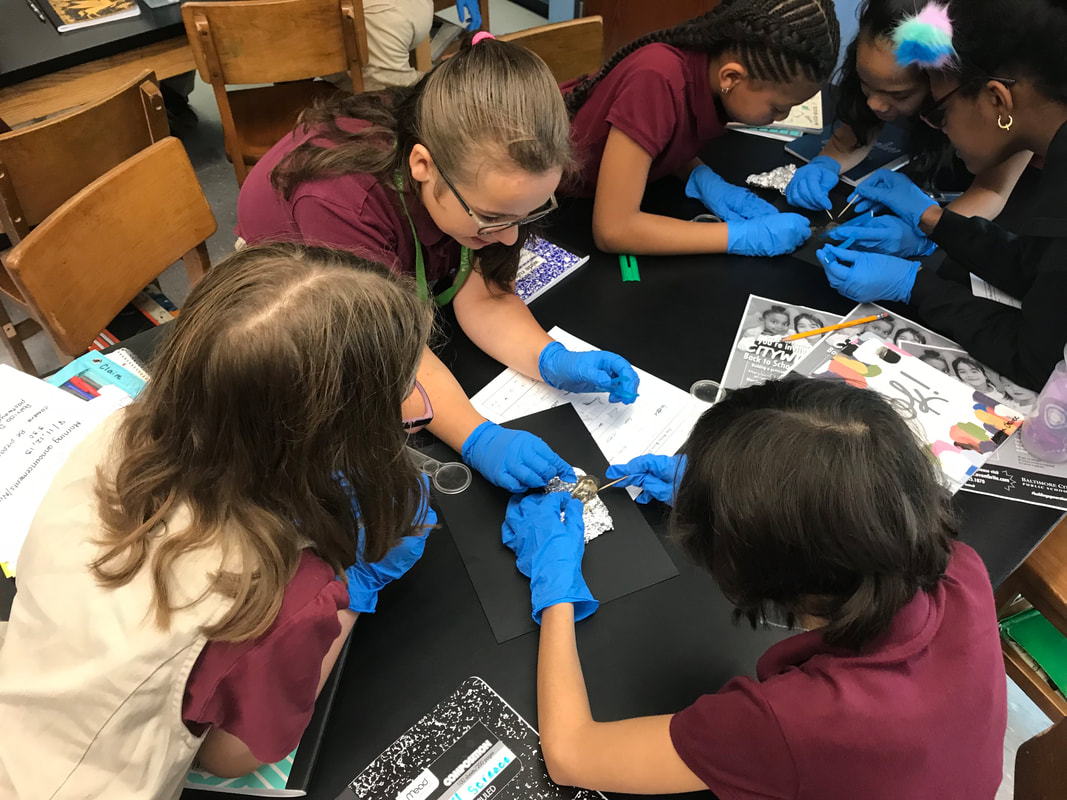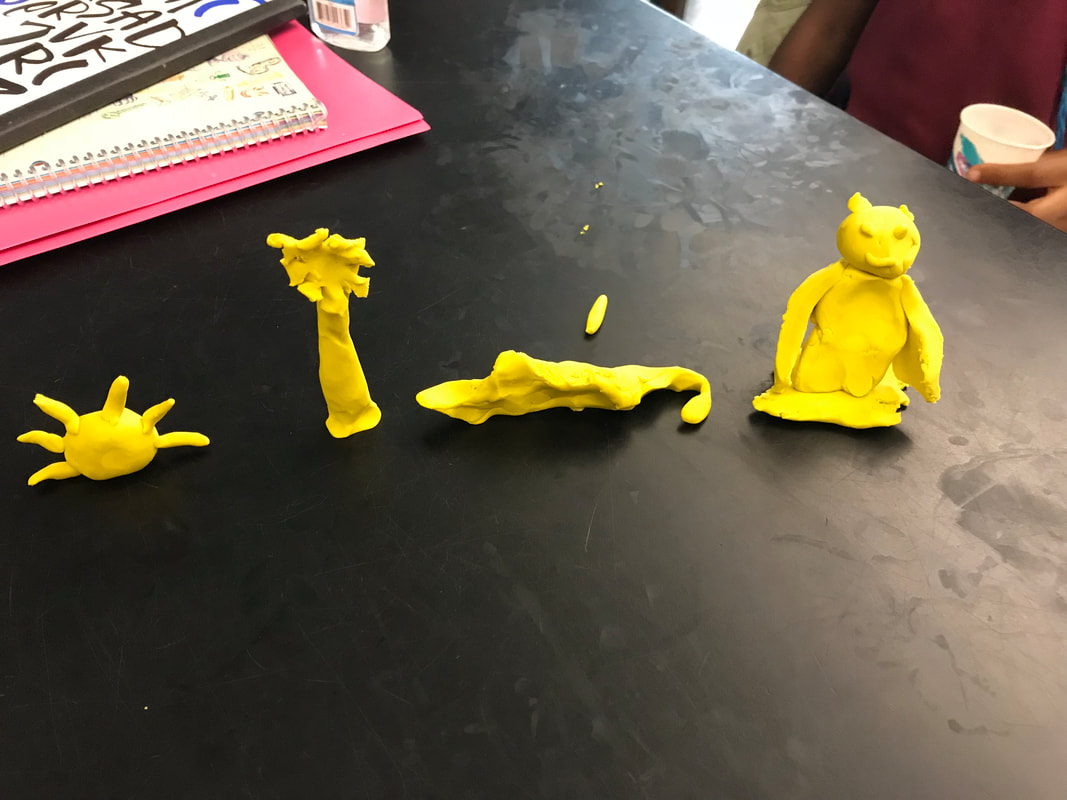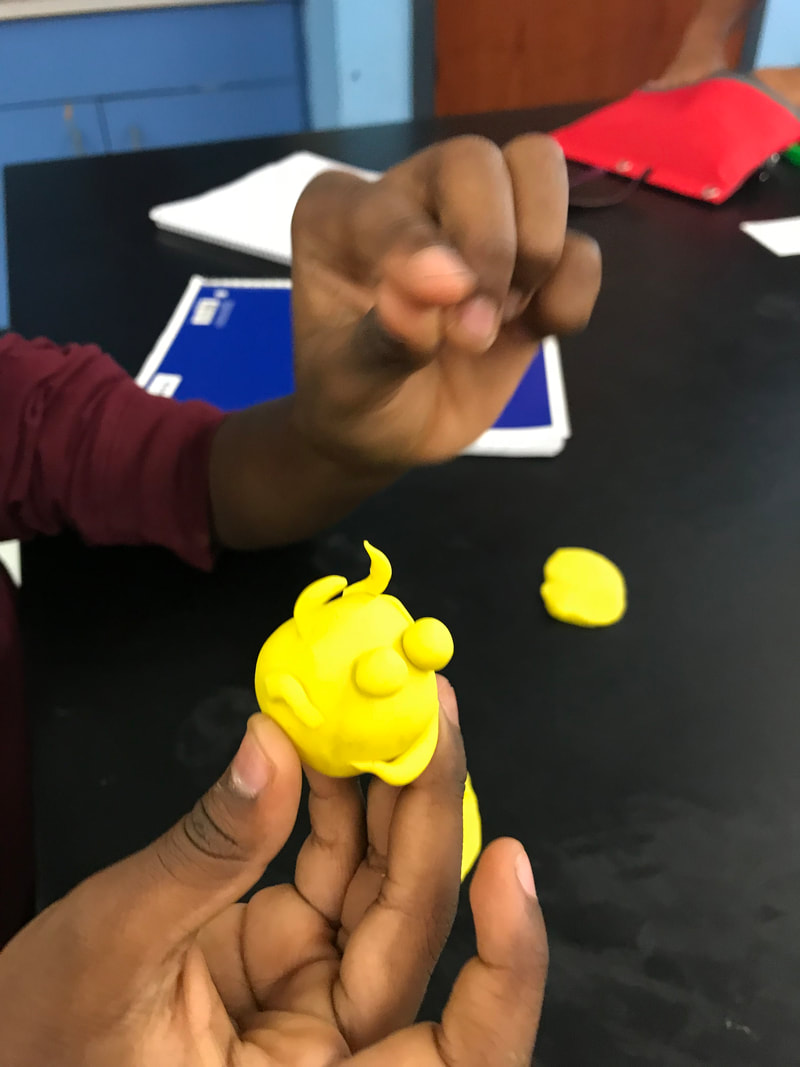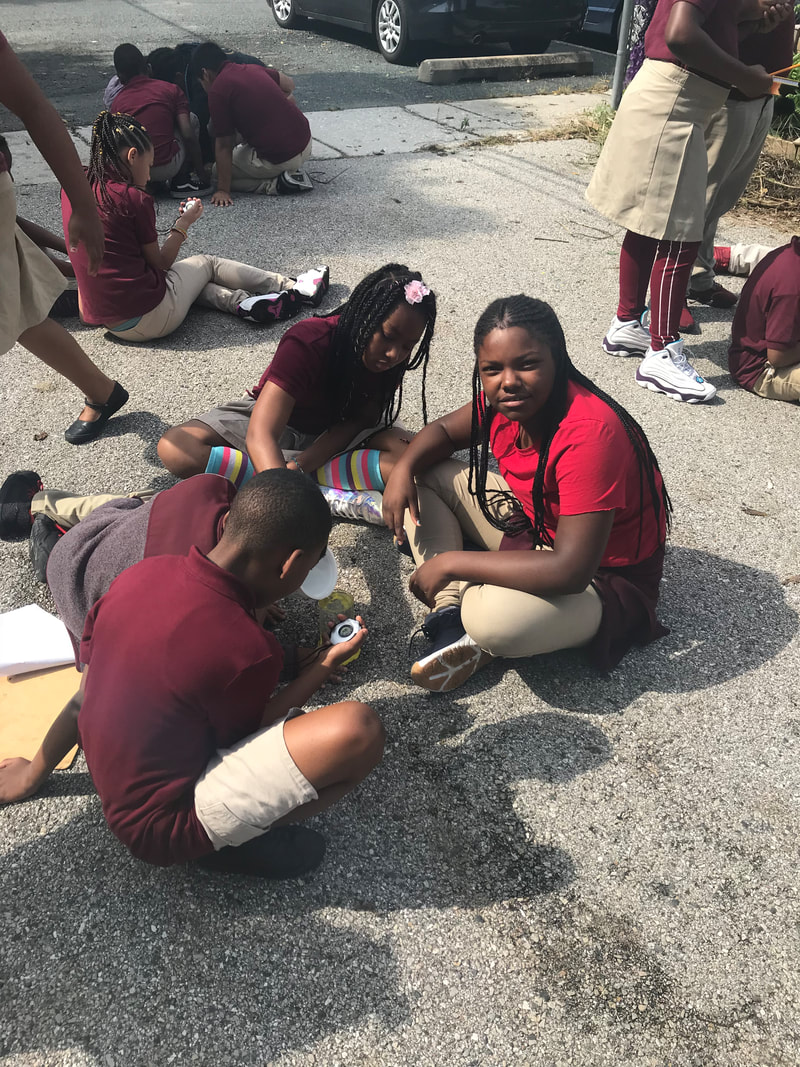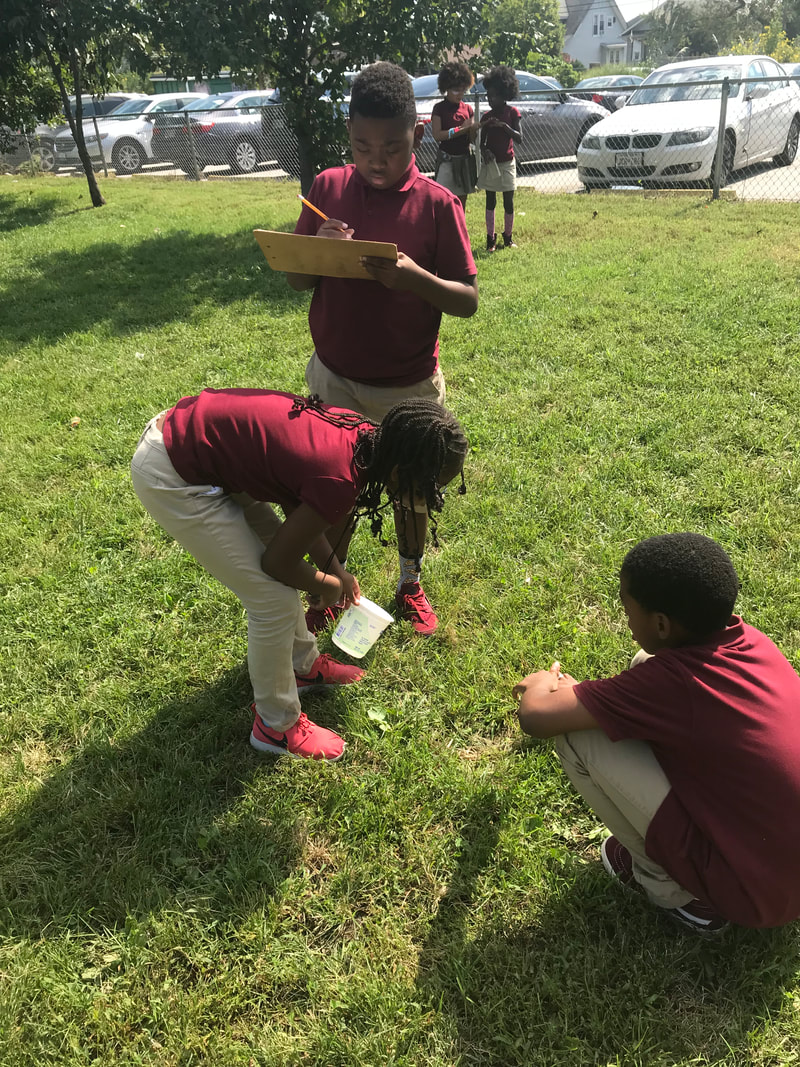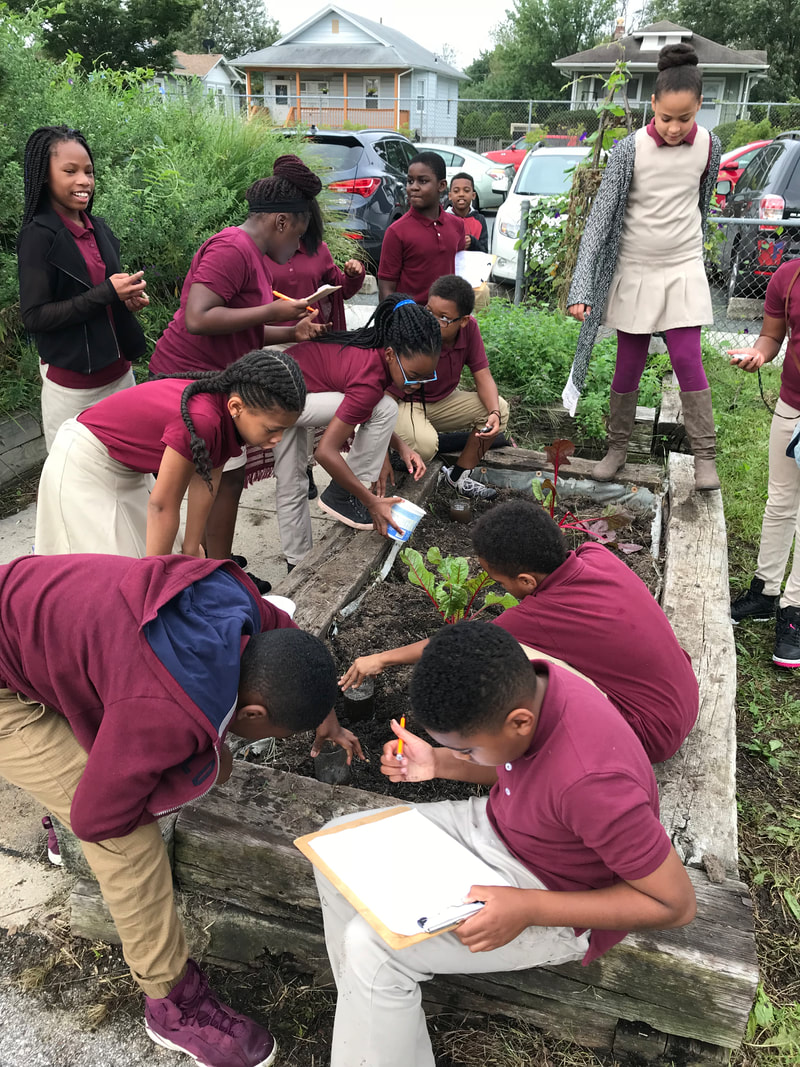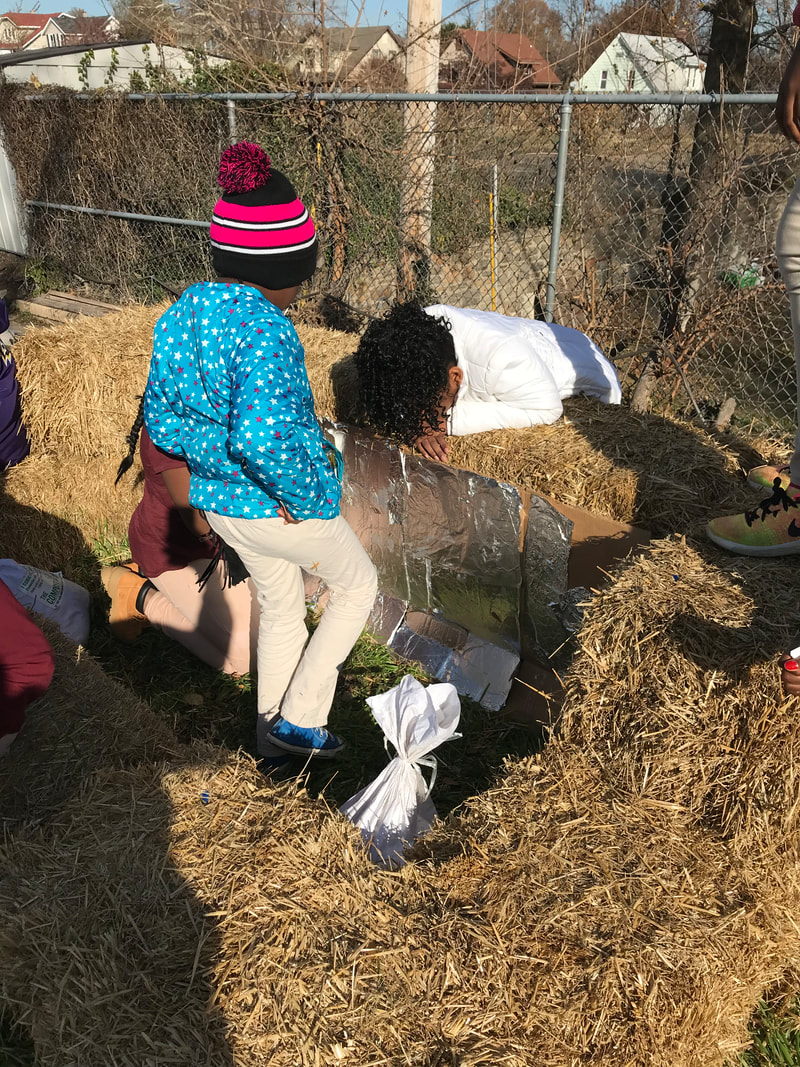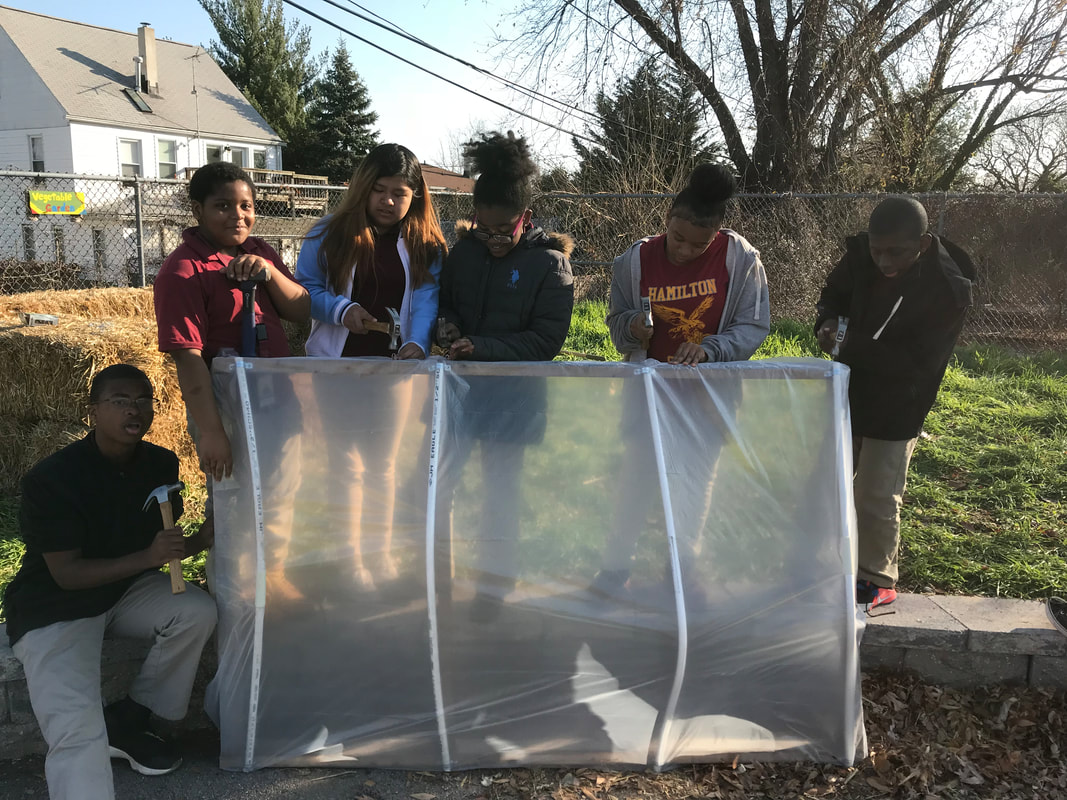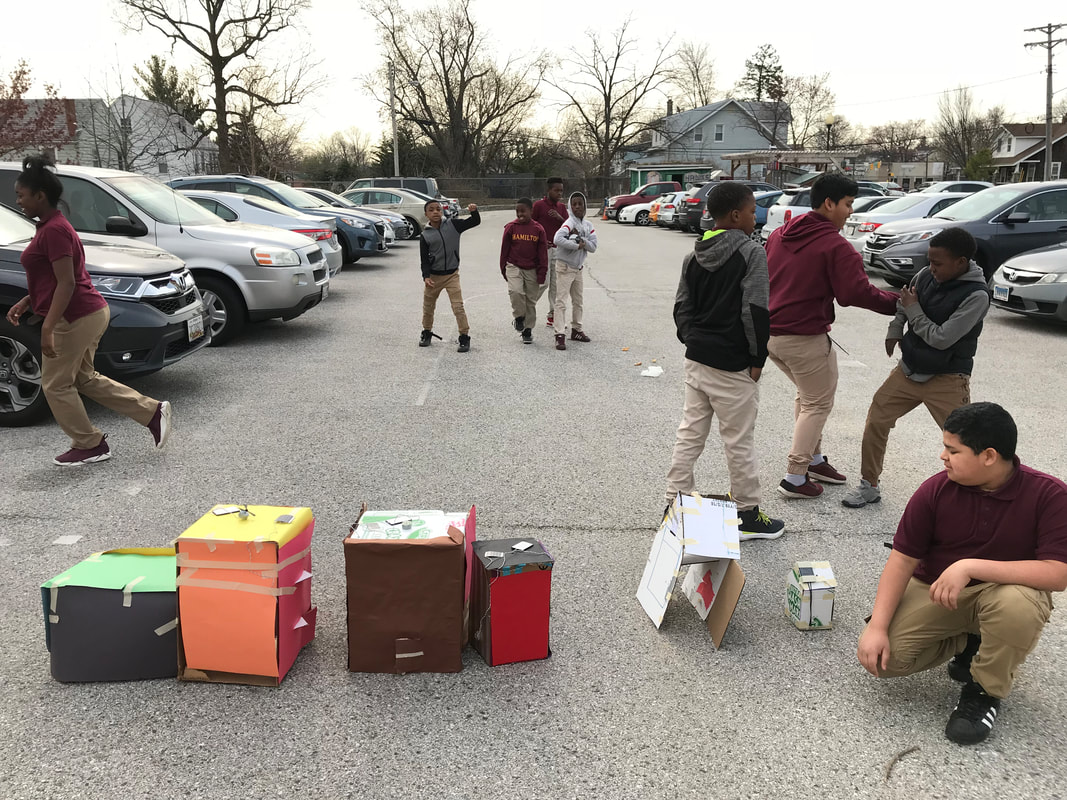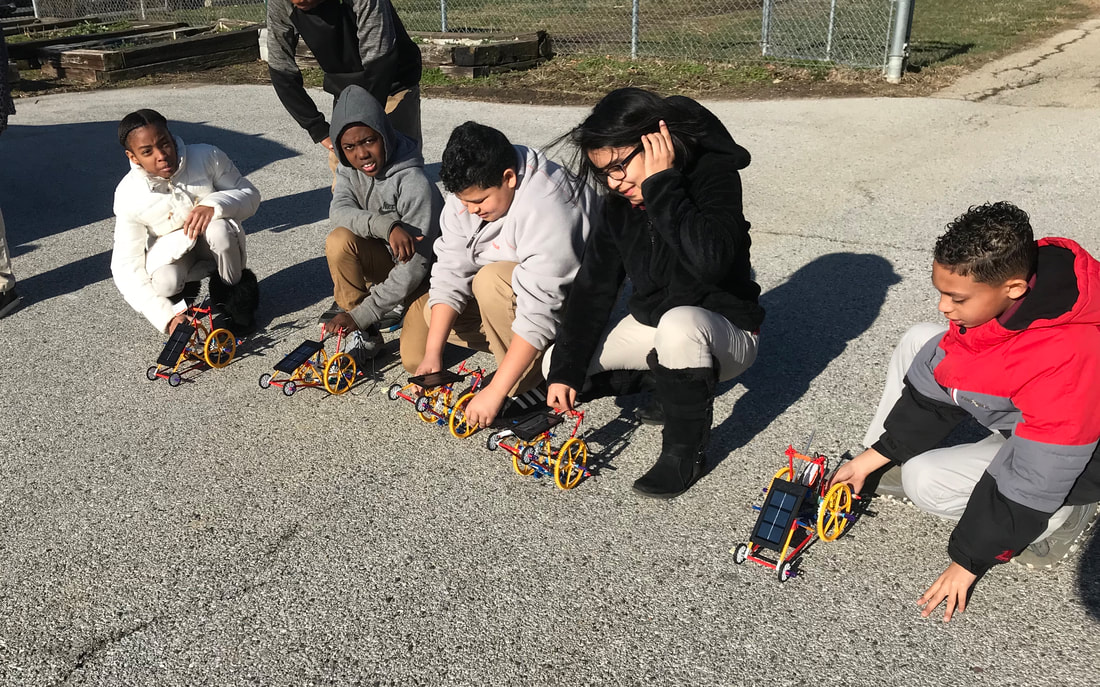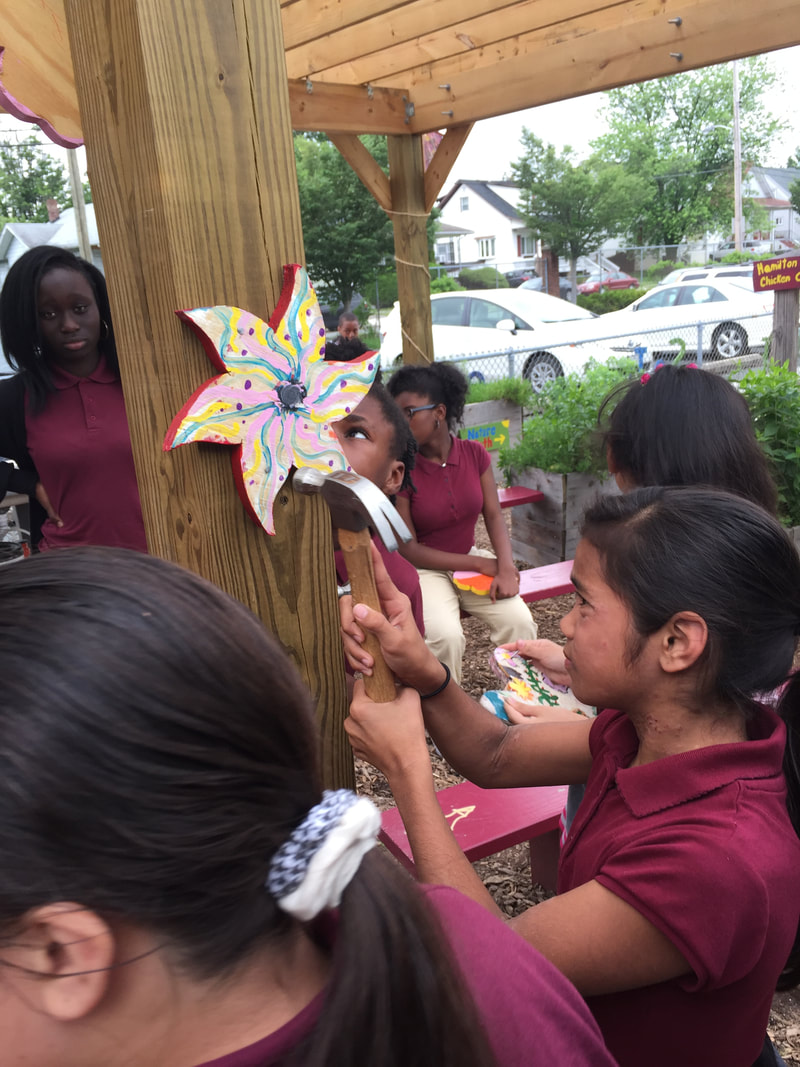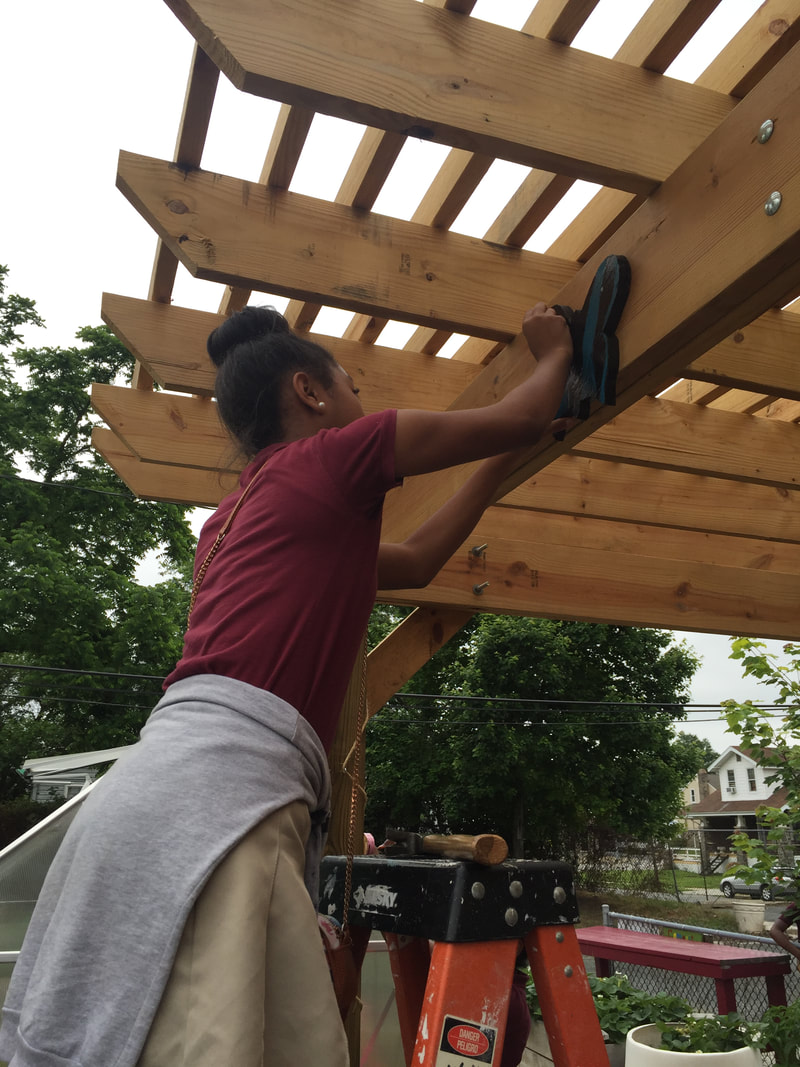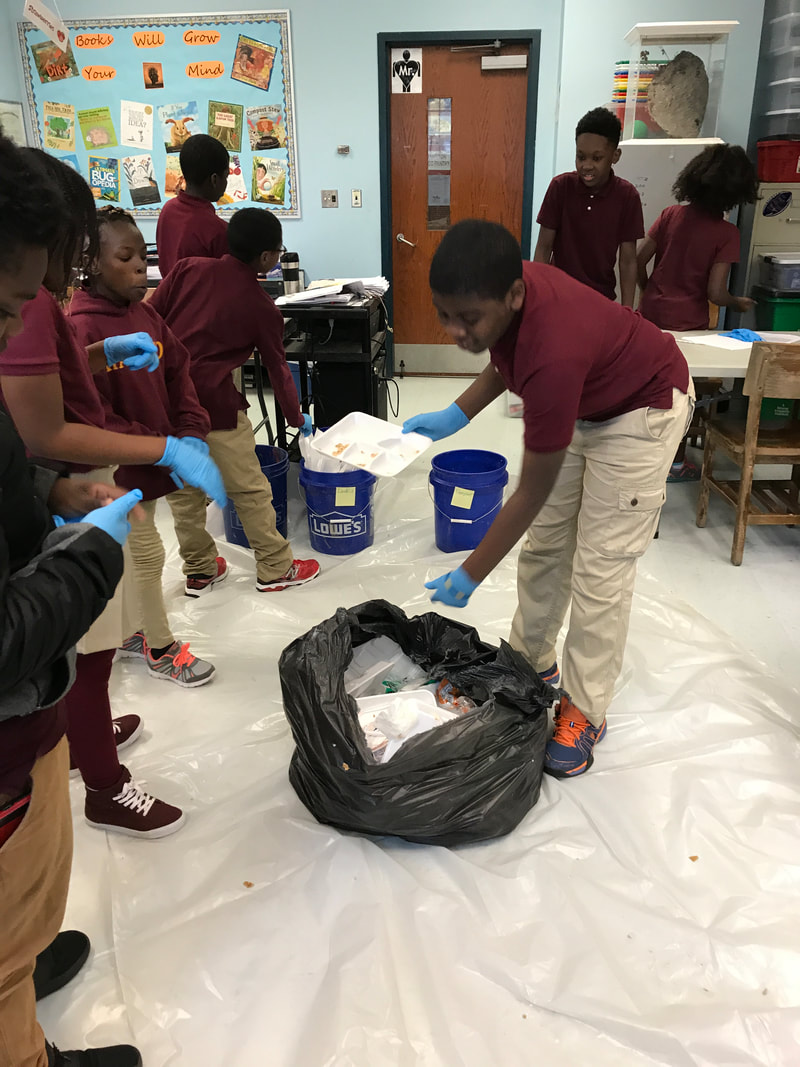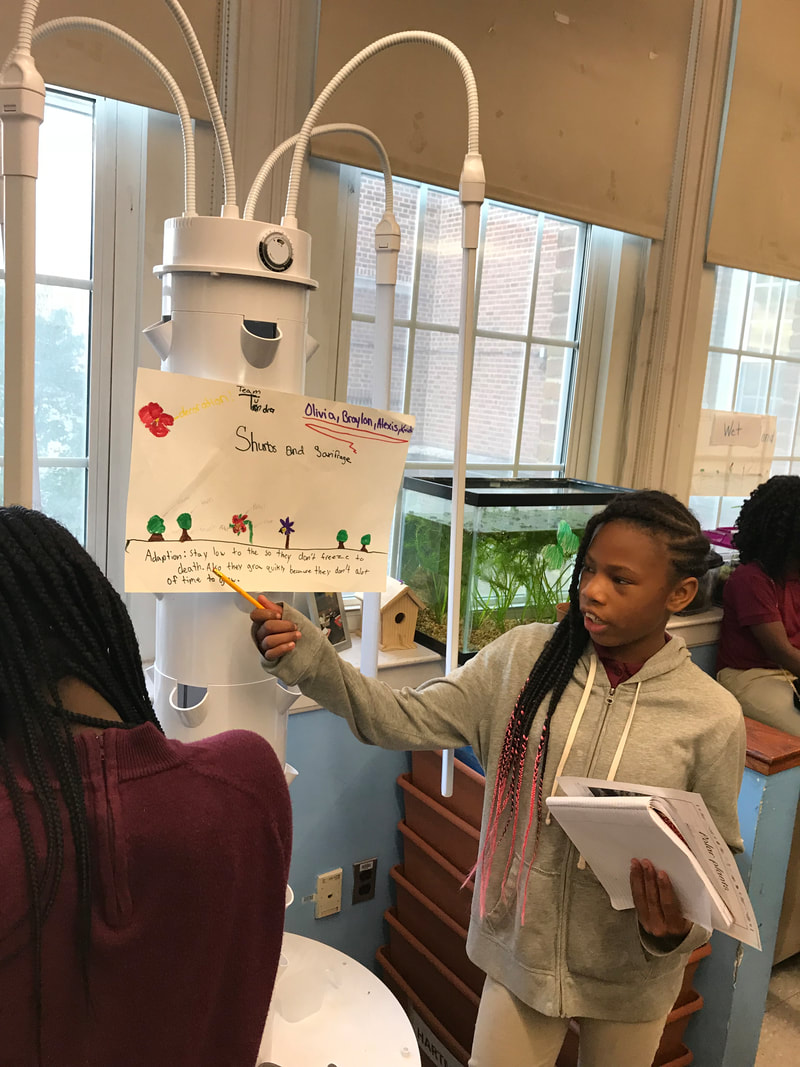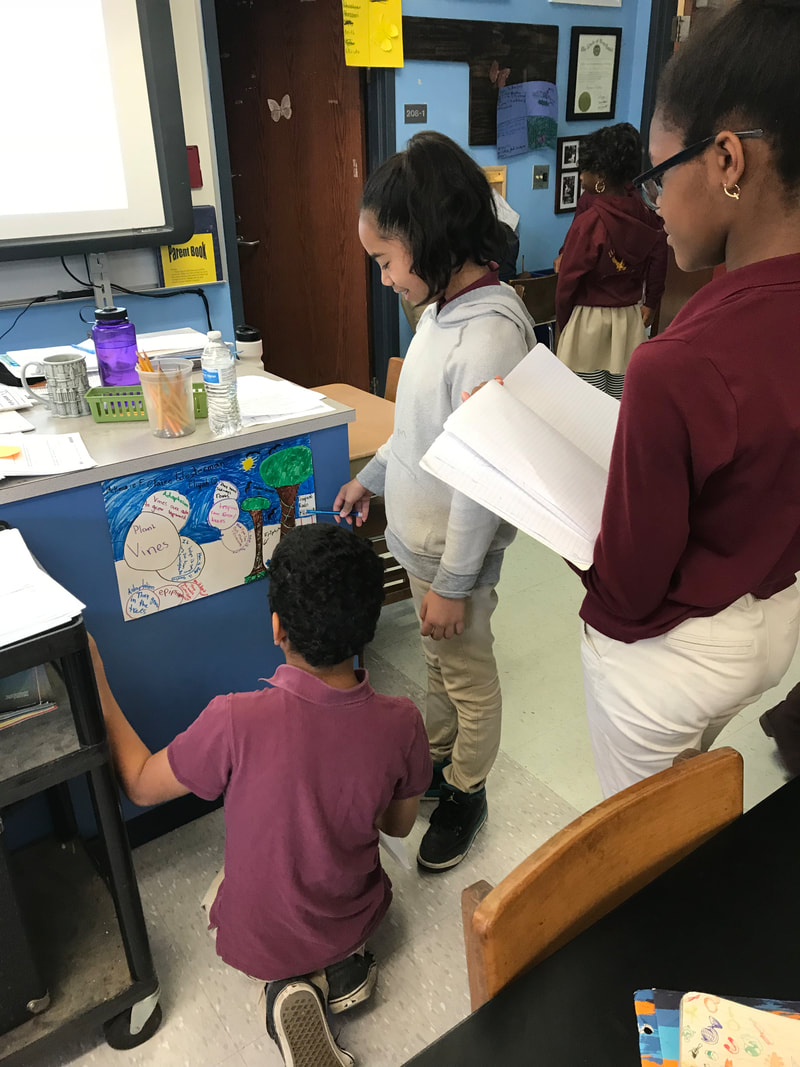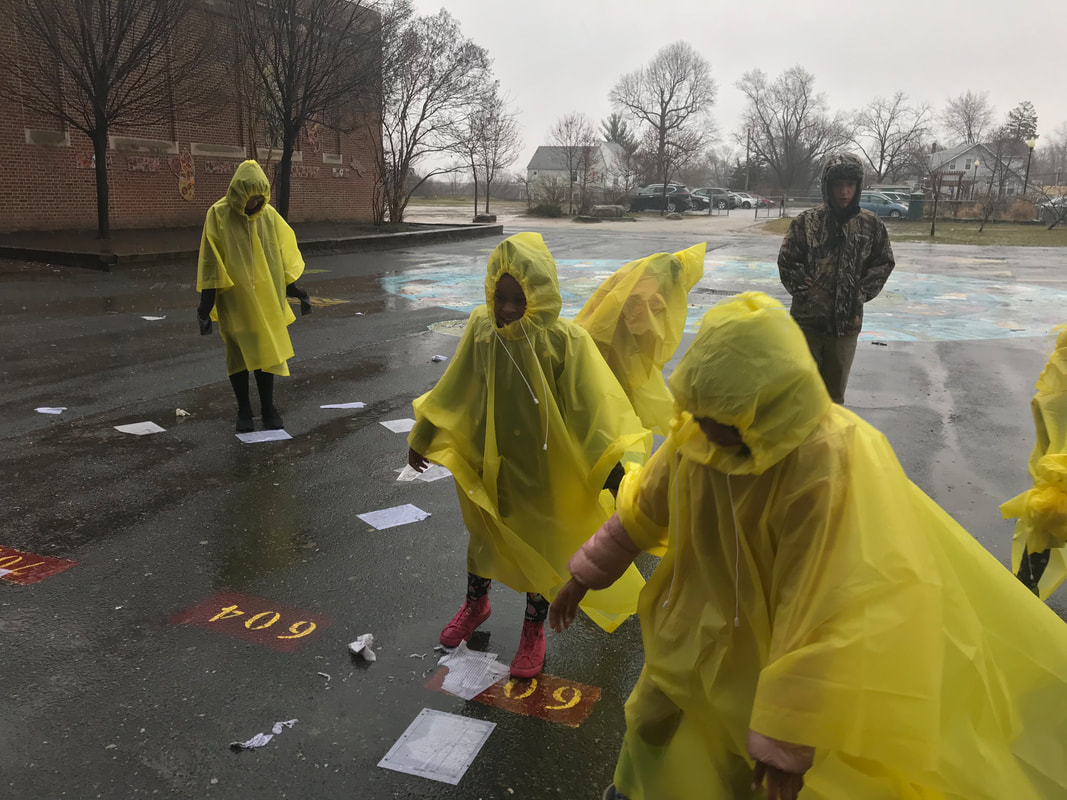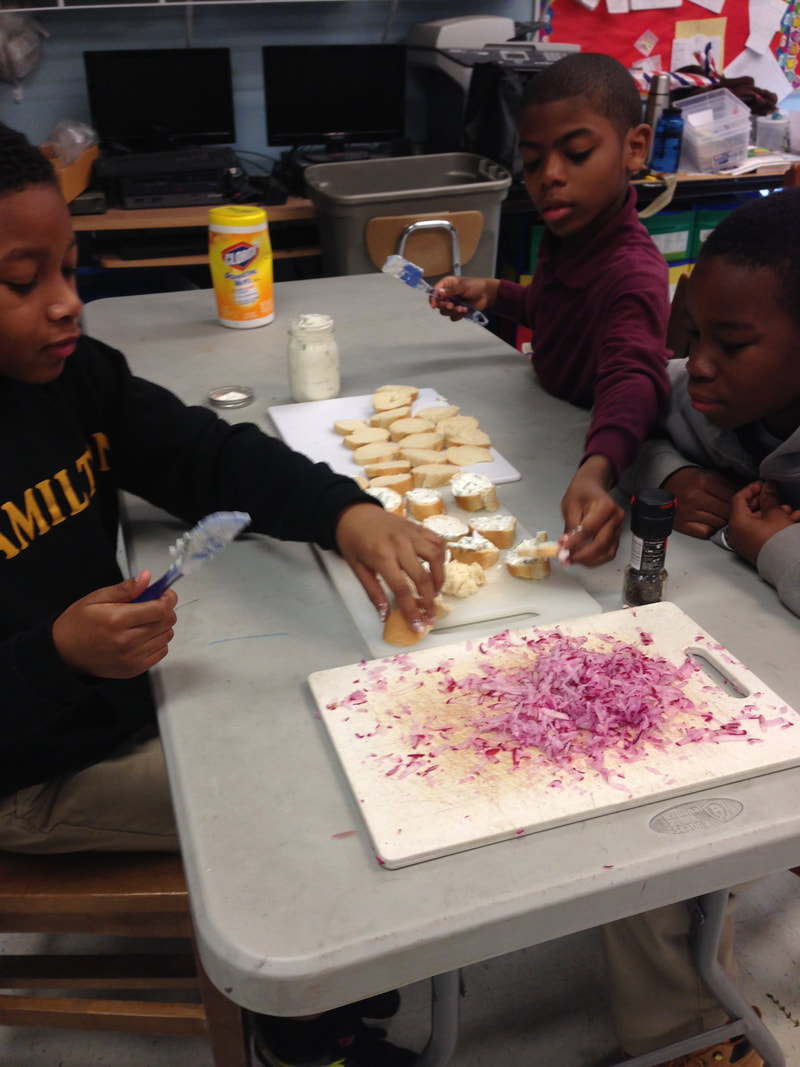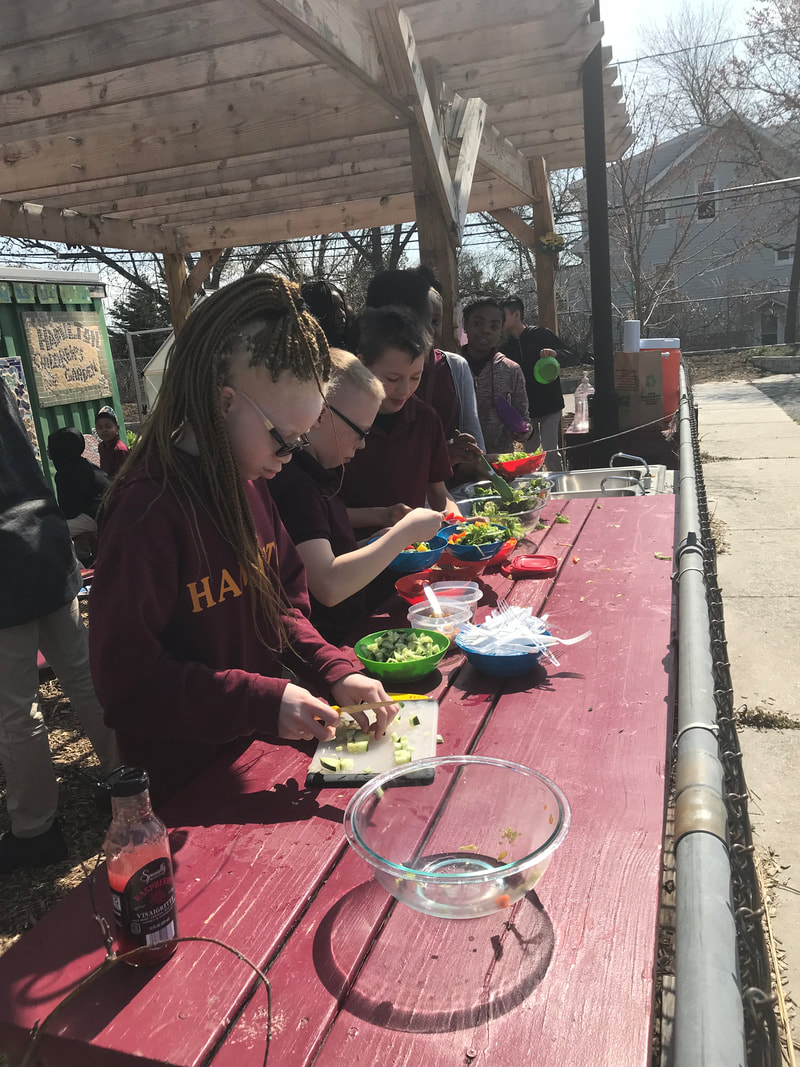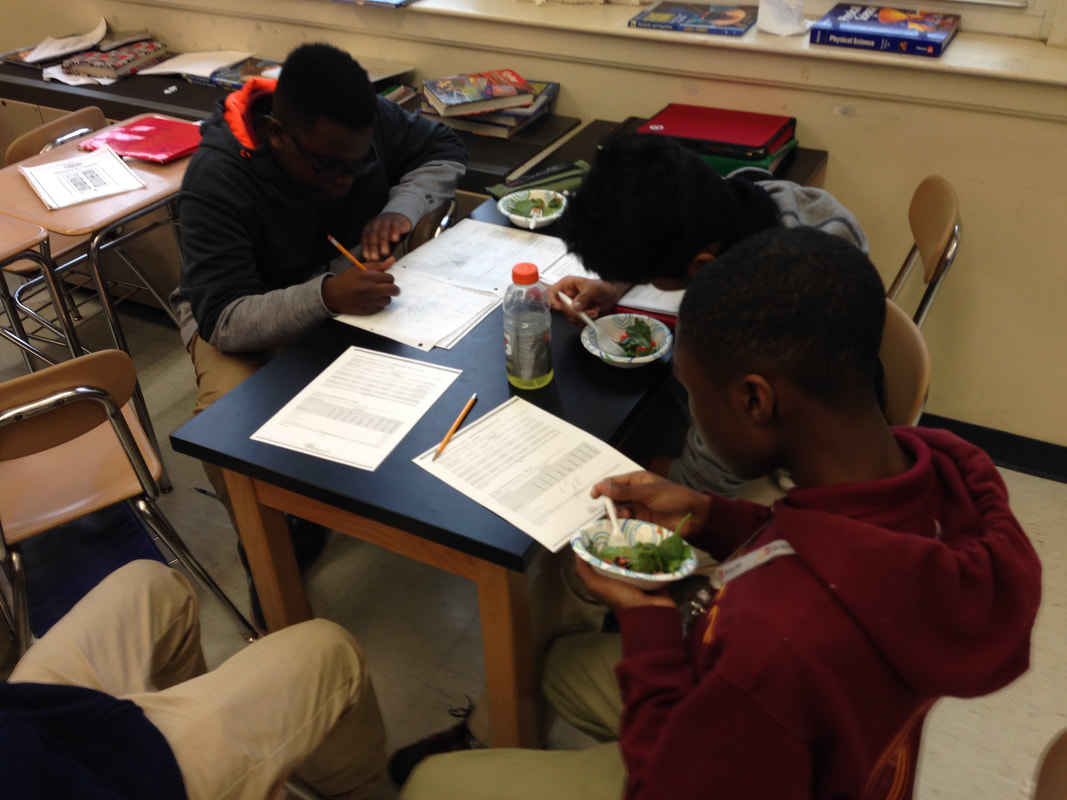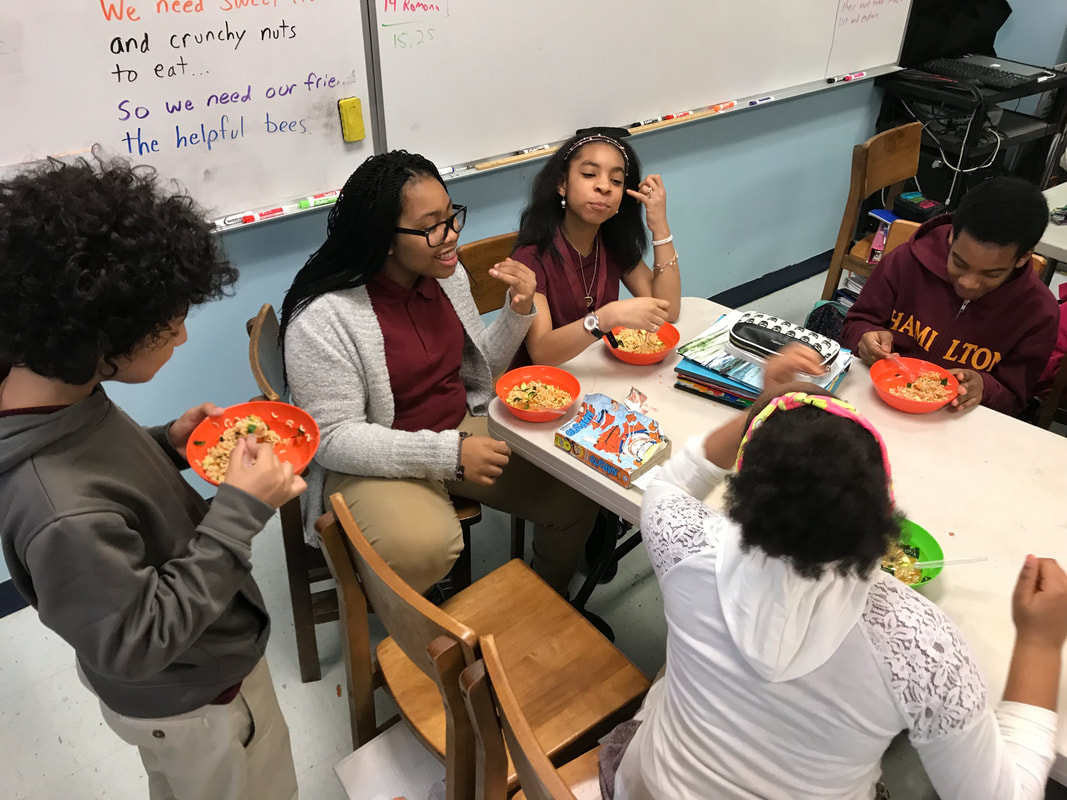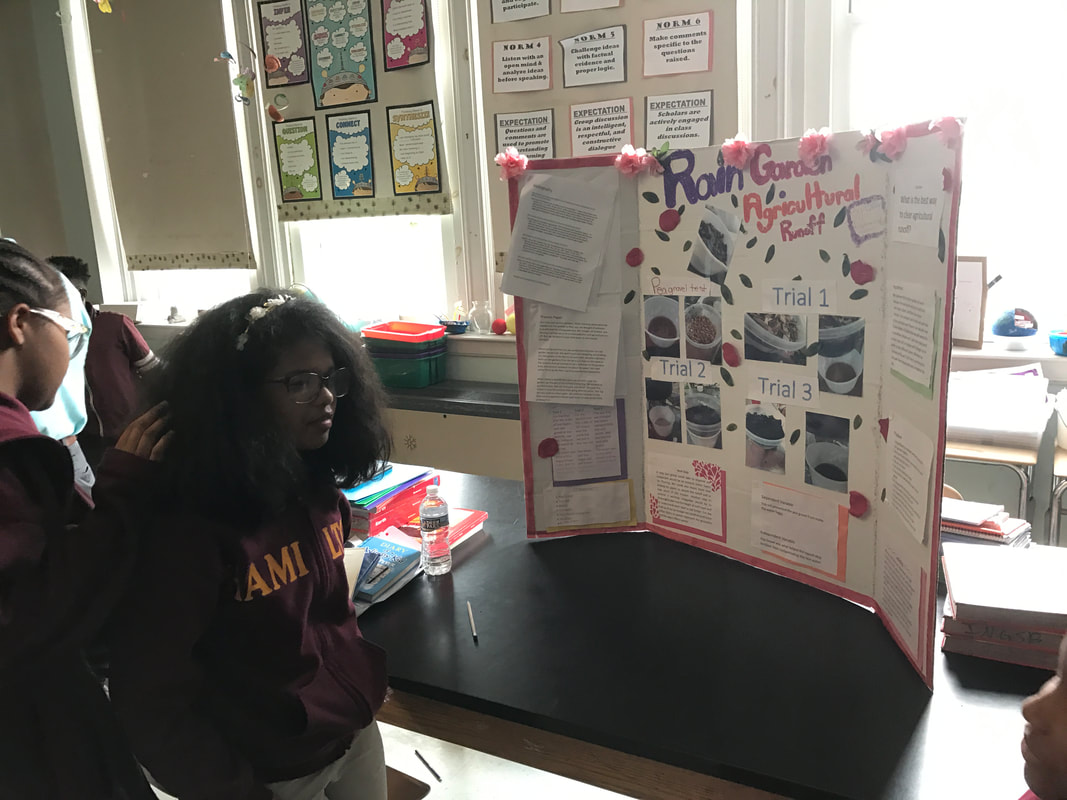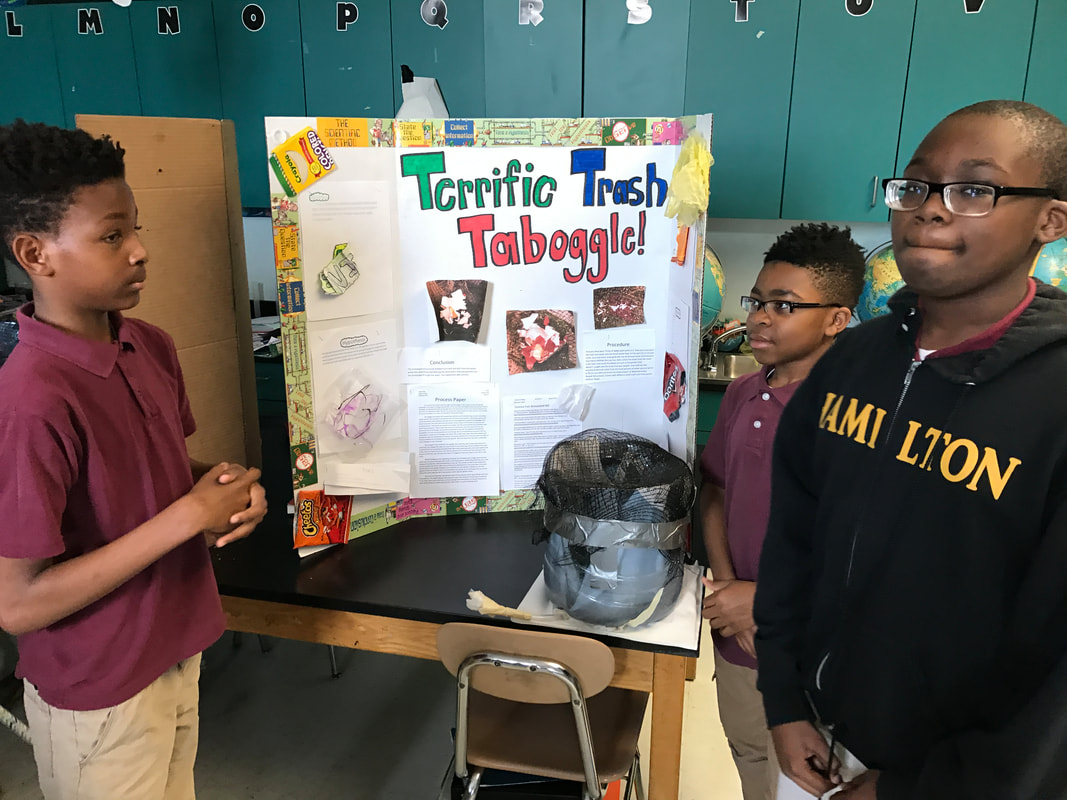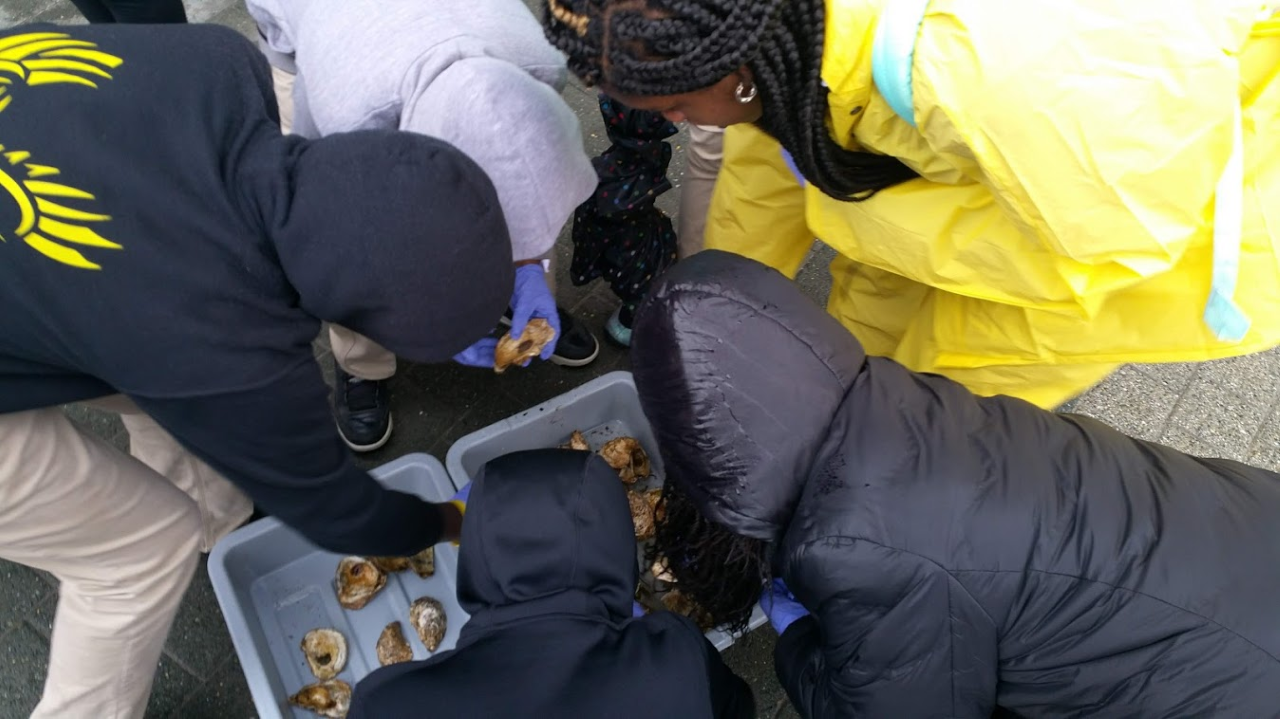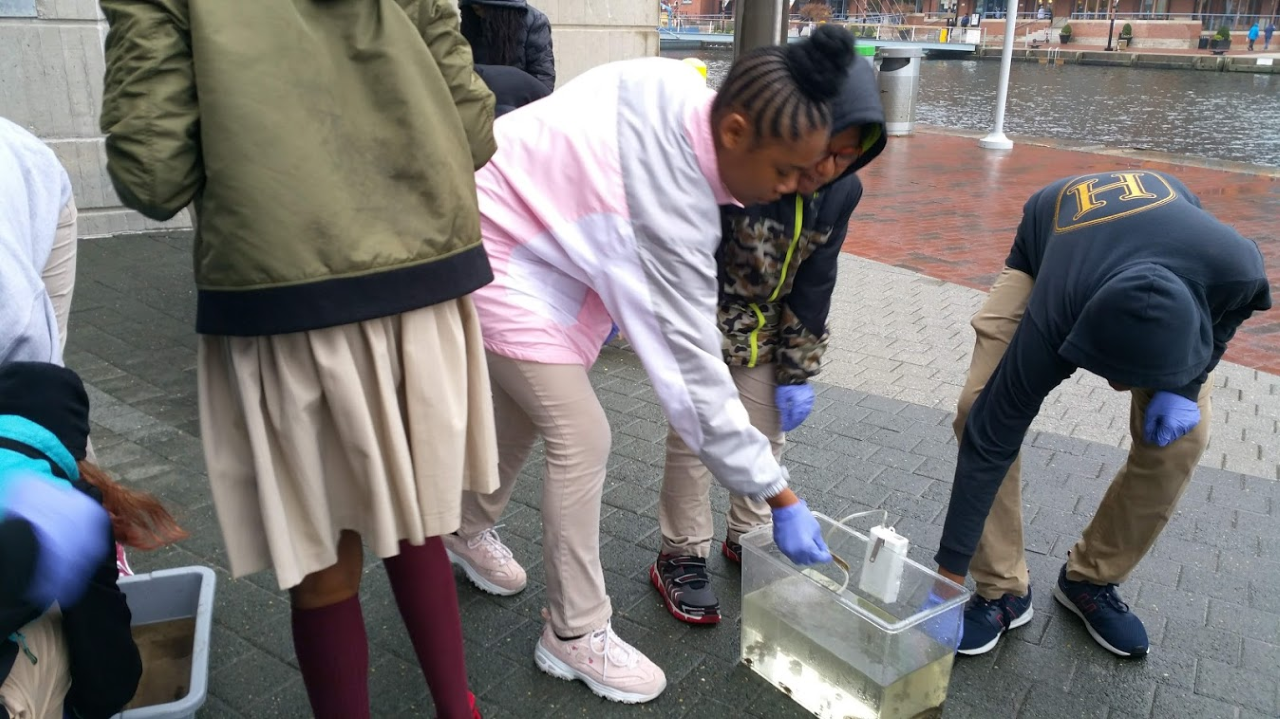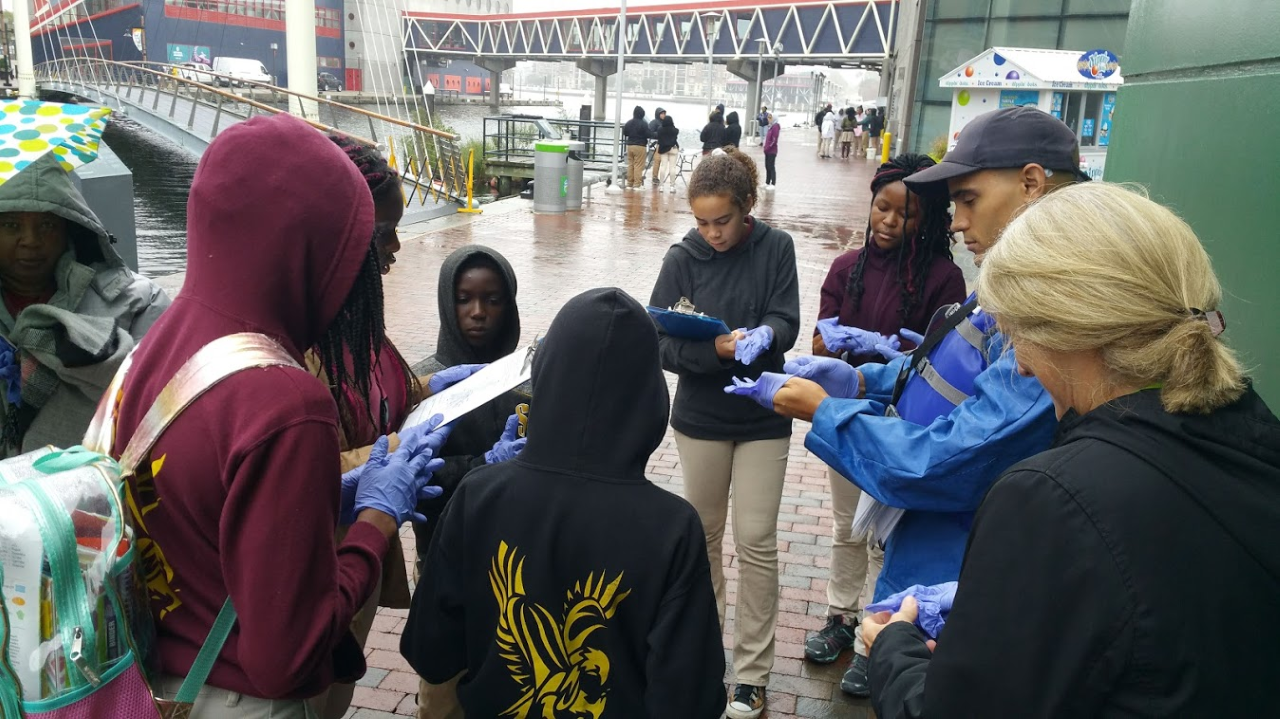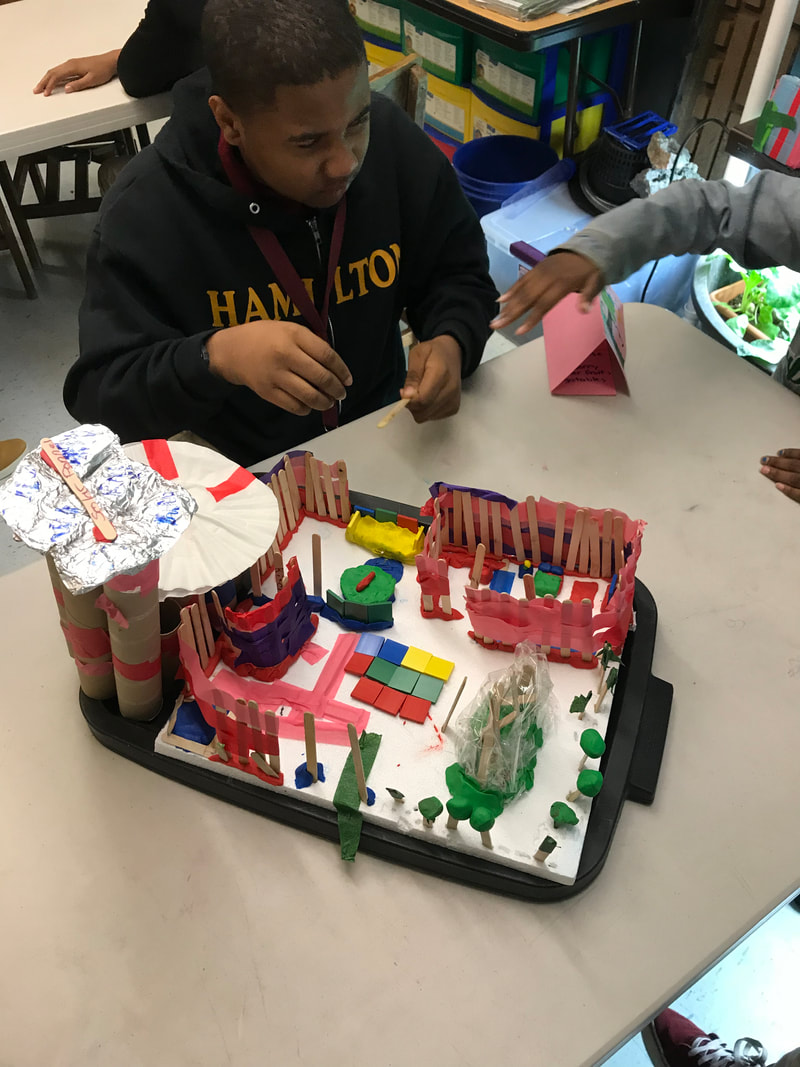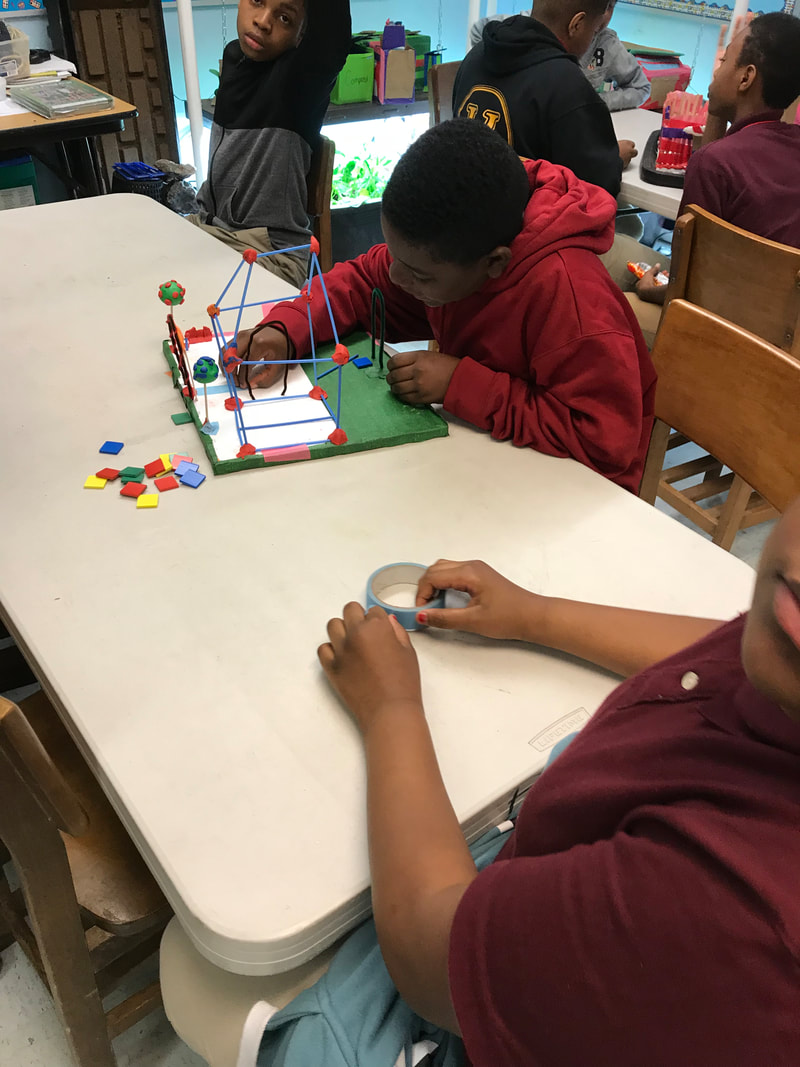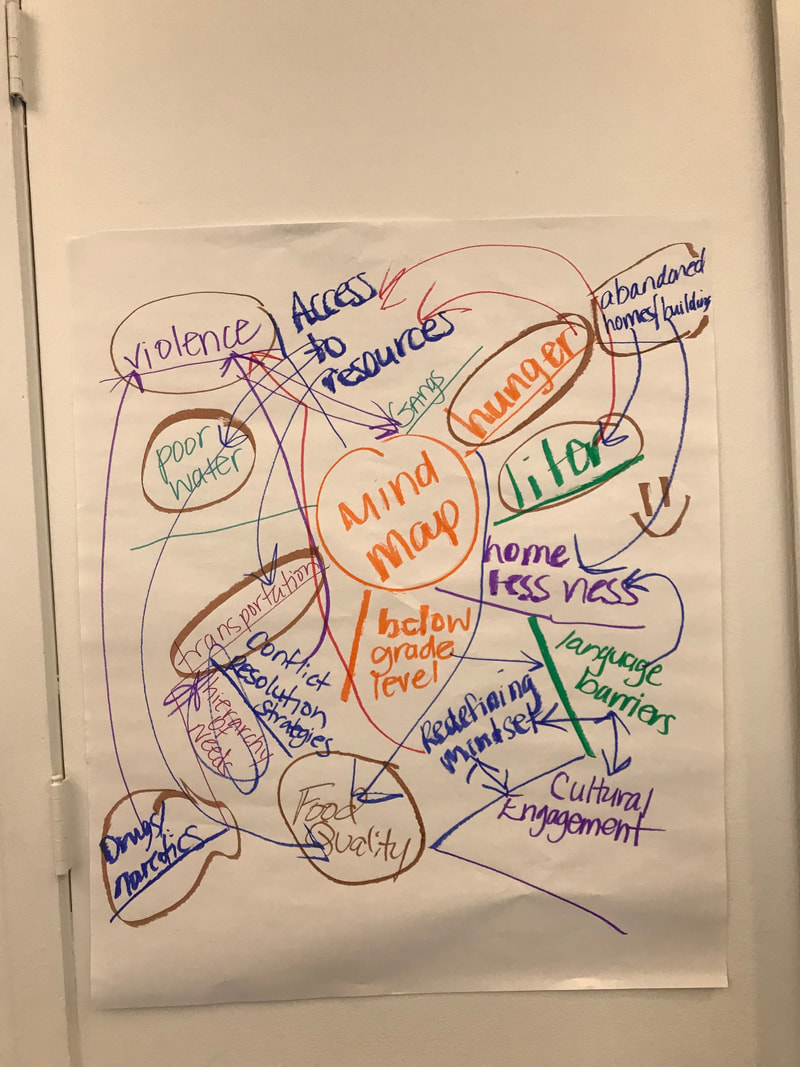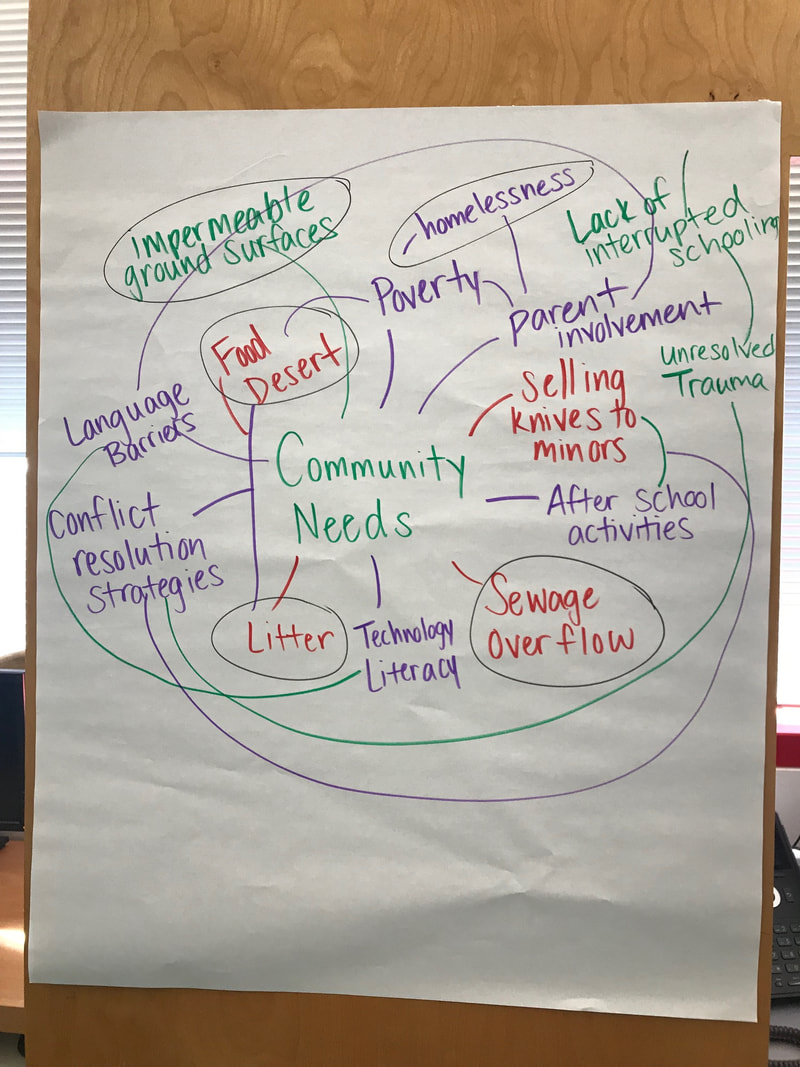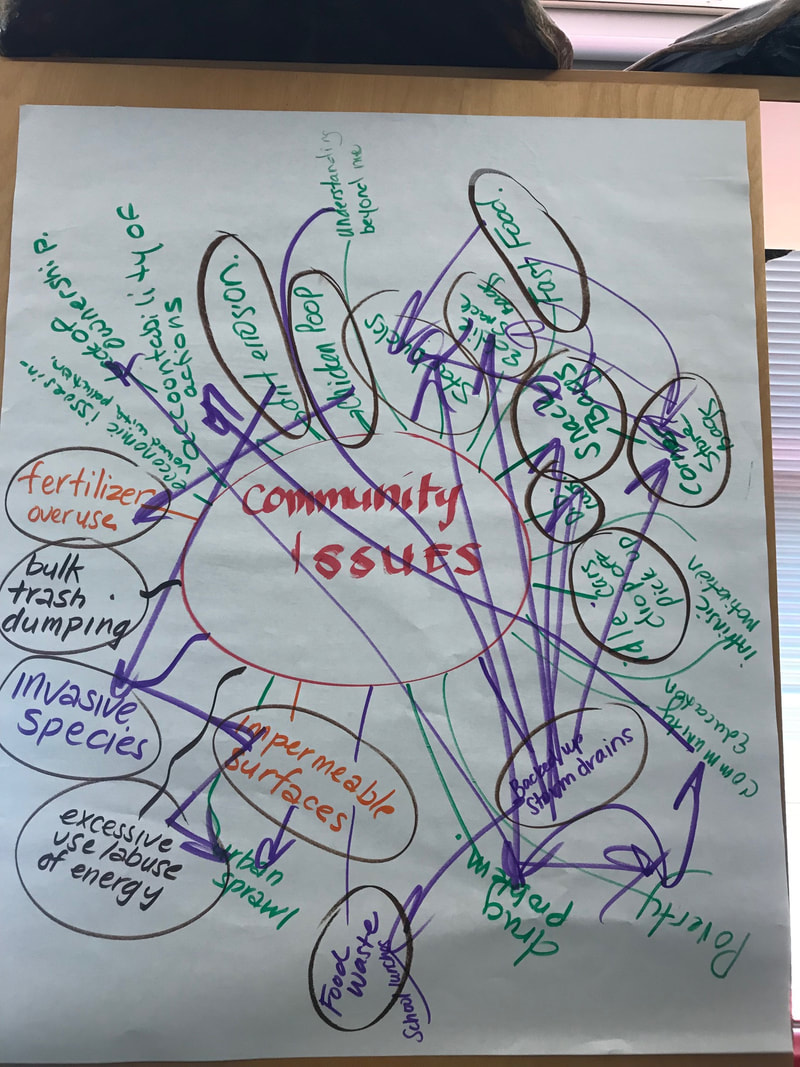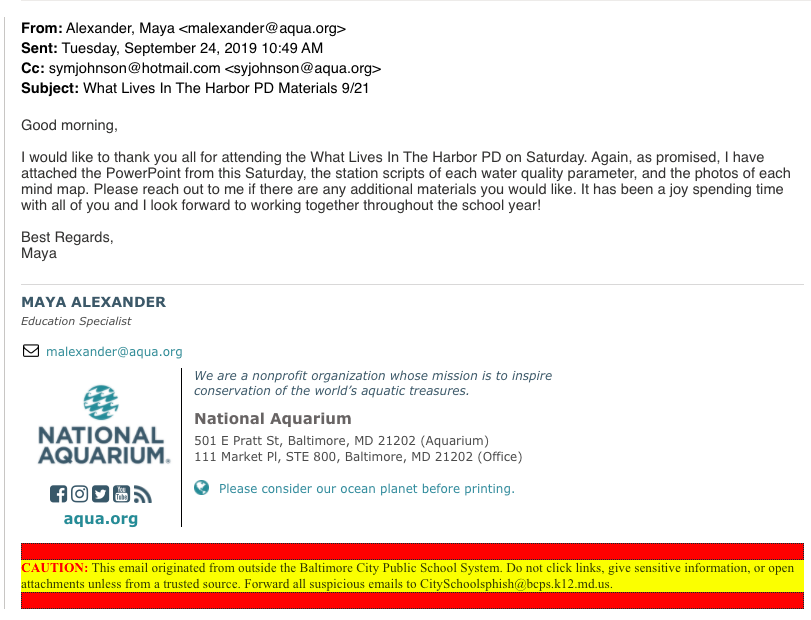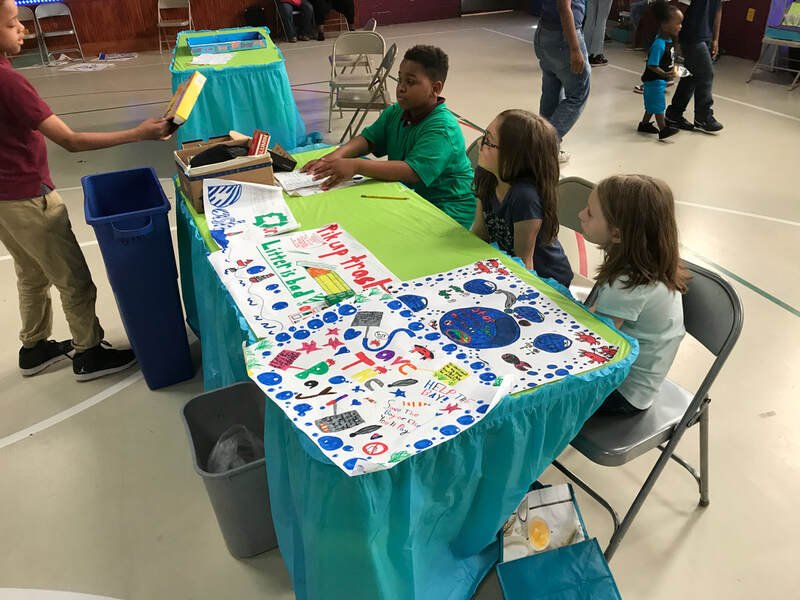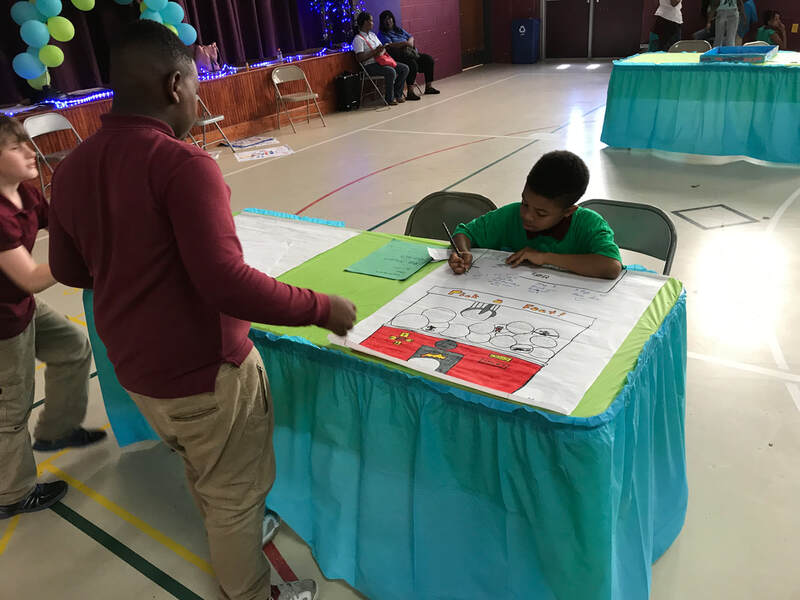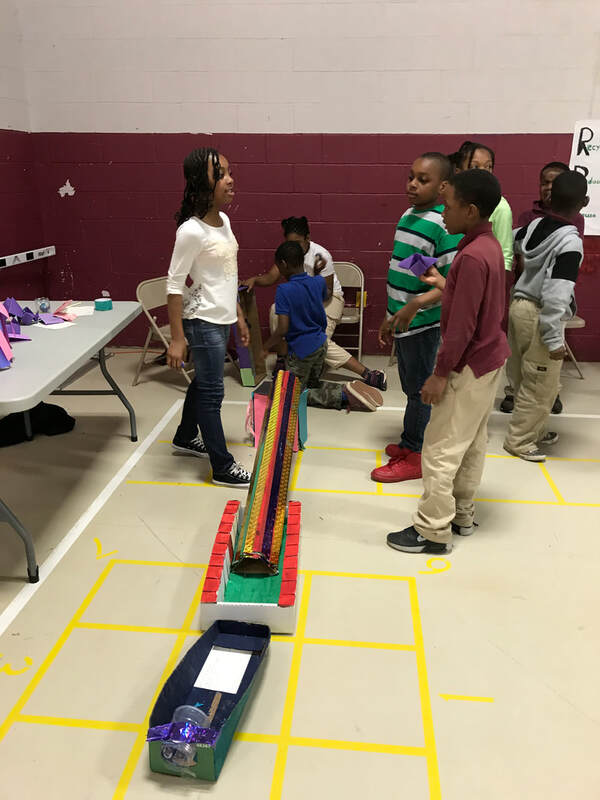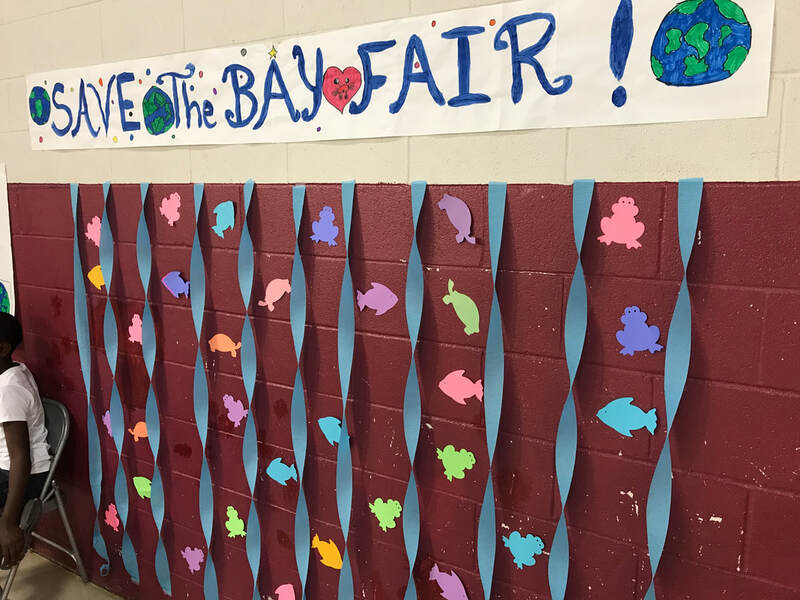Sustainability Education
Objective 1.1 Curriculum and Instruction
Pre-Kindergarten
Above, Pre-Kindergarten students use up-cycled Nature-Scopes to focus on one small part of the garden at a time. Using this technique can help students block out the overwhelming sensory inputs as they pick one thing to focus their attention on. (Fall, 2019).
Above: Pre-Kindergarten students share in planting sunflower seeds after learning about the ingredients of seed-starting mix. Students will continue to observe their seedlings through the rest of the winter and early spring until students help to transplant them outside (or sell them at our annual seedling-sale). (Winter, 2020).
During the Lunch for a Bear lesson, Pre-Kindergarten students learned about what animals get from their habitat. Students took turns playing the role of a bear looking for a diverse diet in our pretend forest. Once students found their food, and we discussed what would happen if a bear could not find everything it needs from its habitat, students created their plate. Students went on to draw a bear habitat and their own habitat the following week. The class discussed how our needs are the same. (Fall, 2019).
Kindergarten
Kindergarten students enjoy a Spring visit to the garden to observe how things are changing. Students created a 4 part observation of changes in the garden throughout the school year. (Spring, 2018)
After an interactive lesson about the importance of trees in a habitat, kindergarten students get silly as they become dancing trees. (Winter, 2017).
Above: Thanks to a visit from Irvine Nature Center, kindergarten students meet a Screech Owl. During the lesson, students learned about native species and how owls are part of a food chain.
Below: Kindergarten students show-off their owl masks after meeting with, and learning about a native Maryland owl. (Winter, 2017)
Below: Kindergarten students show-off their owl masks after meeting with, and learning about a native Maryland owl. (Winter, 2017)
1st Grade
Left: 1st graders make their way through our nature path on the lookout for early spring-blooms. (Spring, 2018)
Right: First grade students gather leaves for a leaf-rubbing project and a lesson how why trees lose their leaves. (Fall, 2019).
Right: First grade students gather leaves for a leaf-rubbing project and a lesson how why trees lose their leaves. (Fall, 2019).
Left: Students transplant seedlings into the garden for our fall planting. Students continued to maintain, and harvest the various food-plants grown in our schoolyard gardens (Fall, 2019).
1st graders make careful observations and drawings of various plants as they learn about the parts of a plant (Winter, 2019).
2nd Grade
In the side-by-side images below, 2nd graders had the good fortune of finding both a monarch caterpillar and a young monarch butterfly in the garden classroom. Thanks to this discovery, the class completed a lesson on life-cycles and made observations of the monarch as possible (Fall, 2018).
|
2nd grade students share their excitement as they observe a Bess Beetle in the garden. Bess bugs occupy several logs in the garden and are a favorite species to observe for our students. During this lesson, students learned about the beetle's role in the habitat as a decomposer. (Fall, 2018)
|
At one learning station in the garden classroom, 2nd grade students read a National Geographic Kids magazine and discuss what they read. (Fall, 2019)
|
In the four images below, student work from a Social Studies lesson can be seen. During the lesson, students learned about the historic impact of settlement on the prairie habitat. Students also learned about how the prairie is now recovering in some areas thanks to conservation efforts. (Winter, 2019)
3rd Grade
In the two images below, 3rd grade students can be seen completing an "Interview With a Worm" activity. Students observed the worms using hand-lenses during a unit about decomposers. (Winter, 2018)
3rd Graders learn about the interconnectedness of living things in a habitat during an interactive food web activity. (Winter, 2019)
In the series of pictures above, progress in our 3rd grader's indoor cucumber-farm can be seen over time. (Winter/Spring 2018)
4th Grade
4th Grade students learned about how land-use choices can have an impact on the Chesapeake Bay by designing their own shoreline spaces and then discussing how run-off, pollution, and habitat destruction might impact the ecosystem. (Winter, 2019)
4th grade students explore watershed pollution through modeling in the two photographs below. This experience was part of a unit about how humans impact the bay. Students went on to assess our schoolyard as a possible source of bay pollution.
5th Grade
In the two images below, 5th grade students explore The Great Marsh at Echo Hill Outdoor School (left), and learn about salinity in the Bay while navigating its waters (right). Annually, our 5th grade students take a 3 day trip to Echo Hill Outdoor School on the Eastern Shore as they connect the many bay-related lessons that they have been taught with the actual bay. Our students explore topics including diversity of life, human impact on the environment, and succession as they explore the Echo Hill property and connect with nature in new and unique ways. (Spring, 2019 - and every Spring!).
5th grade students worked with a resident artist through the Arts Every Day program to design and install a ground mural focused on spreading awareness around pollution and storm water run-off. Taking center-stage on our recess play yard, the mural is a focal point of the student-experience at our school and is featured in lessons concerning human impact on the environment and stormwater issues. (Spring, 2017)
Below are 3 student work samples from a lesson in which 5th grade students researched one of Earth's biomes. Students created posters about their assigned biome, and then compared the biomes to each other, and to our own biome. (Winter, 2019).
In a lesson designed to familiarize 5th graders with the many living things that call the Chesapeake Bay home, students researched one species that is native to the bay and created a mini-poster about the organism. Students shared out about their organism to the class as we developed an understanding of the wide variety of life in the bay. (Winter, 2019).
In the three photos below, 5th grade students can be seen dissecting owl pellets, and creating modeling-clay food webs based on what they learned from the owl pellets and some additional research. (Fall, 2018).
In the three photos below, 5th grade students can be seen testing the permeability of various surfaces in our schoolyard. Students used the data gathered to better understand the overall permeability of our schoolyard by using pictures and measurements from GoogleEarth. Students went on to develop a plan for mitigating some of the impact on the bay from non-porous surfaces on the schoolyard. (Fall, 2018).
6th Grade
In the 5 photos above, 6th graders can be seen learning about the potential for solar energy in various applications. In the left most column, students are seen building a straw-bale insulated garden with a clear plastic covering. Students monitored the mini-hoop house through the winter to determine if the structure successfully kept plants warmer than they would be outside. In the center column, solar ovens are tested in the top photo, while a design drawing is seen in the bottom photo. Finally, the right-most column shows students testing out solar powered cars made from the toy K'Nex. In all cases, successful experimentation was completed and learning about the potential of solar energy was accomplished. (Fall/Winter, 2018)
In the 2 photos above, 6th grade students can be seen installing painted flower and butterfly art in our garden spaces. Students engage in the garden space through art, especially during the winter months when outdoor learning is less palatable. (Winter/Spring 2019).
In the photo above, 6th grade students can be seen completing a trash-dissection activity. The goal of the activity was for students to see how much of a randomly selected trash bag from our cafeteria is recyclable, compostable, and landfill-bound. (Winter, 2018).
In the 2 photos above, 6th grade students can be seen presenting plant adaptations to their classmates. Students learned about the adaptations of a particular plant by researching the plant and connecting the adaptation described to the conditions of the plant's habitat. (Fall, 2019).
In a watershed lesson, 6th grade students braved a rain storm to see first-hand how water conveys litter, sediment, and other pollutants on our schoolyard asphalt. After our observations, students identified ways in which we could mitigate the effects of storm water run-off on the school property. (Winter/Spring, 2018)
7th Grade
Food Justice/Growing your own food/yummy tasting.
|
In the images to the left and above, 7th grade students can be seen preparing, serving, and eating produce from our schoolyard gardens. With each tasting, students are asked to grade the food in categories such as taste, texture, and consistency. Additionally, connections are made between growing your own food, having access to nutritious foods, and nutrition. (Winter/Spring 2017).
|
In the 2 photos above, 7th graders can be seen presenting their environmental-engineering ideas after completing a lengthy lesson on how we can use engineering to help solve some of the pressing issues facing the earth. Students presented to other students, parents, and several guest judges. (Fall/Winter 2018).
Above are four photos of HEMS students I took during our "What Lives in the Harbor" field trip to the National Aquarium. Students measured water quality parameters at the Inner Harbor and compared their data with the kind of animals that can withstand those parameters. (Fall, 2019).
8th Grade
In the two photos below, 8th grade students can be seen working on building model earth-houses. Students completed this project as the capstone to a unit focused on earth-friendly building practices. Students researched assigned components of earth houses and then shared about their assigned component. After those presentations, students designed and built a model using the components described in the presentation. Students presented their designs to their classmates when finished. (Winter, 2018).
Professional Development
1.2.1 Staff Awareness of Green School Application
We applied for an extension in spring, 2020, so our kick-off staff meeting was held in Fall, 2019 in-person! Below is the powerpoint presentation used at the staff meeting.
1.2.2 Environmental Education Professional Development
Below is documentation of staff environmental education professional development.
6th grade science teacher, Sandi Knutson, also attended the October 21, 2019 MWEE training and provided the photos from the session below, as well as the email thanking her for participating. She was unable to locate the associated certificate.
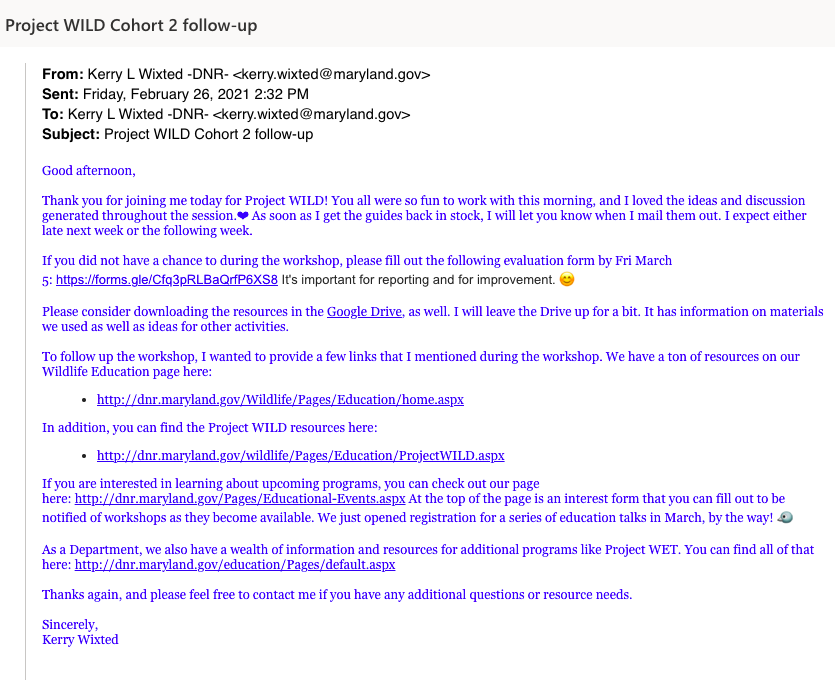
The email above was sent to Hamilton staff member, Angela Haynes, who completed the Project Wild! Training. This email is currently The only evidence of participation, but a certificate is expected soon.
Objective 1.3 Sustainable Schools
1.3.2 Systemic Partnership
Attached below is a letter from Baltimore City Schools Sustainability Analyst, Joanna Pi-Sunyer. In her letter, she highlights several of the collaborative projects and professional developments that Hamilton staff have undertaken with district level personnel.
| hamilton_-_systemic_partnership_letter_sy20.pdf | |
| File Size: | 136 kb |
| File Type: | |
Objective 1.4 Celebration
In the four images below, 4th grade students can be seen as they staff their Save the Bay Fair during a whole school celebration event. The 4th grade classes worked together to create awareness-raising signs, up-cycled games, and educational interactive stations which were visited by over 500 participants. (Spring, 2018)
